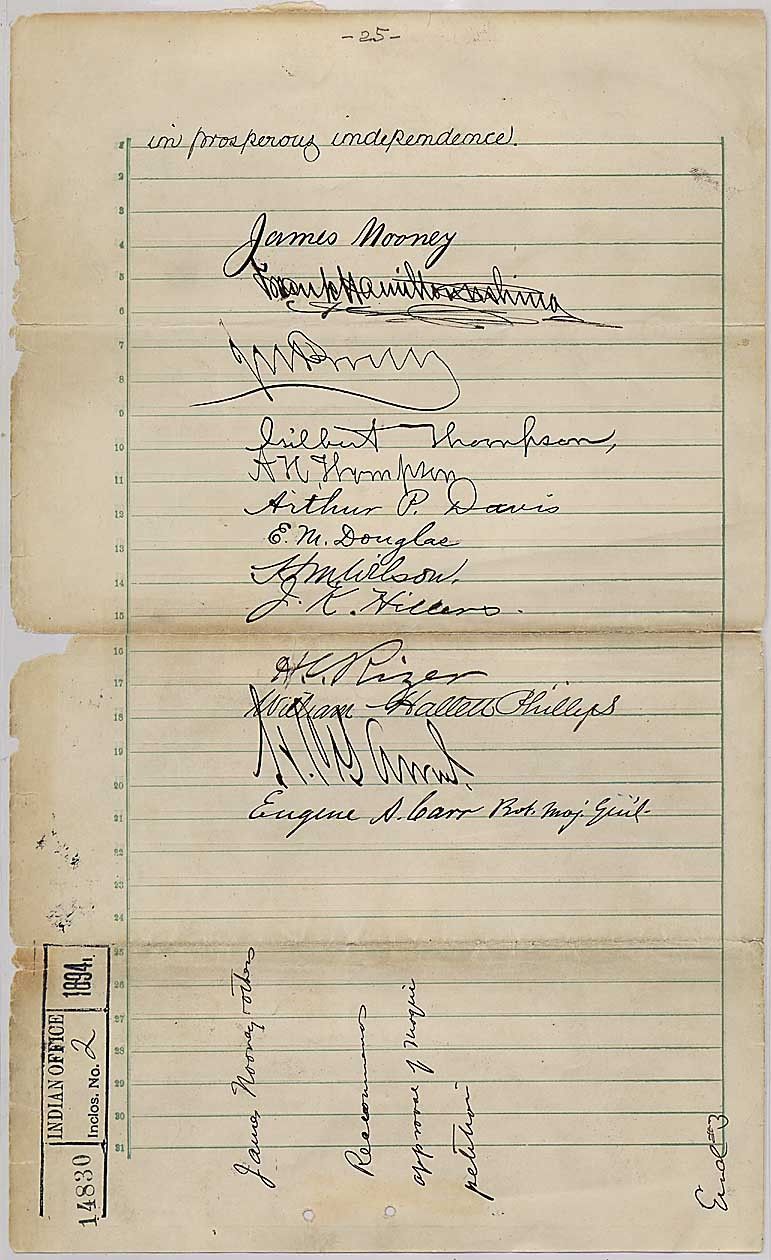Comparing the Dawes Act and a Hopi Petition
Focusing on Details: Compare and Contrast
All documents and text associated with this activity are printed below, followed by a worksheet for student responses.Introduction
During the 19th century, the U.S. government practiced a policy of assimilation toward Native Communities, creating laws that supported this approach. For example, American Indian children were often forcibly removed from their communities and enrolled in government-run Indian boarding schools. These schools forbid students from speaking their native languages and practicing their traditional cultures, as school administrators sought to assimilate the American Indian children into mainstream "White" society. The federal government also changed how Native Communities owned land as another attempt at assimilation.Look closely at the two documents below. Using document-analysis techniques, answer the questions that follow.
The first is the Dawes Act ("Act to Provide for the Allotment of Lands in Severalty to Indians on the Various Reservations"). The second is a Hopi petition asking for title to, and tribal ownership of, their lands.
Click on View Entire Document to see all the pages of the document and a transcript if you need one (scroll to the bottom of the page that opens for the transcript).
Name:
Class:
Class:
Worksheet
Comparing the Dawes Act and a Hopi Petition
Focusing on Details: Compare and Contrast
Examine the documents included in this activity and write your response in the space provided.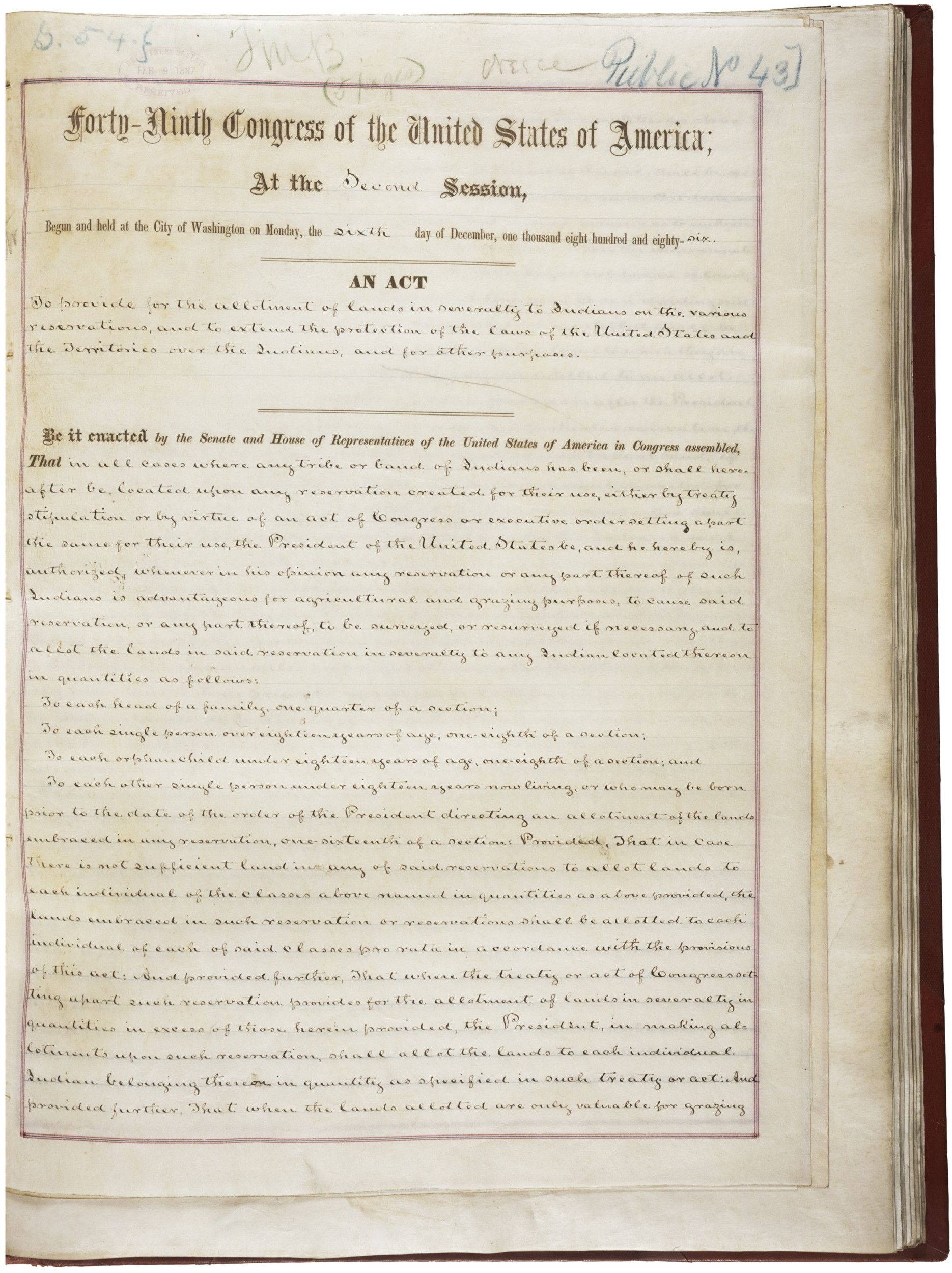
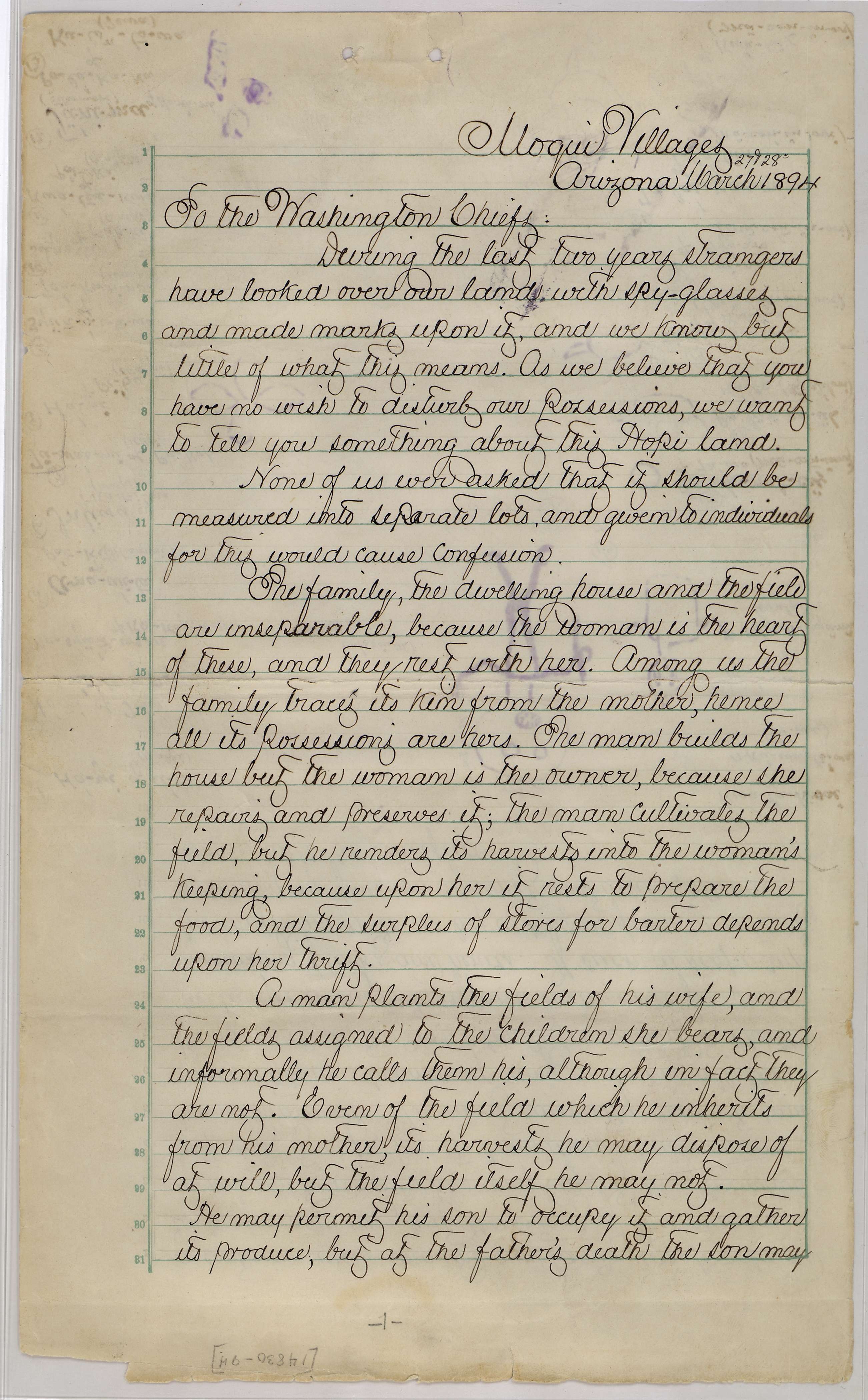
For each document, answer the following questions:
- Who made it? Was it a person or a group?
- When was it made?
- What information is included about who made it?
- Who is the intended audience?
- What else was happening at the time this was created? How does that context (or background information) help you understand why it was created?
- Why was this primary source made?
- Is there a "point of view" or bias? List details from the text that reveal the creator’s perspective or point of view.
Your Response
1
Activity Element
Dawes Act of 1887

2
Activity Element
A Hopi (Moqui) Petition Signed by All the Chiefs and Headmen of the Tribe Asking the Federal Government to Give Them Title to Their Lands Instead of Individually Allotting Each Tribal Member.

Conclusion
Comparing the Dawes Act and a Hopi Petition
Focusing on Details: Compare and Contrast
Consider the following questions in preparation for a class discussion:- What do you think was the relationship between these two primary sources? Were they in opposition to each other? Was one a rebuttal or response to the other?
- Were the two different perspectives presented in the two documents in opposition? Could they have come together?
- These primary sources shows two perspectives on the topic of American Indian assimilation and land ownership. What other perspectives would there have been?
- What perspective do you bring to this topic and source? How does your background and the time in which you live affect this?
Your Response
Document
Dawes Act of 1887
2/8/1887
This "Act to Provide for the Allotment of Lands in Severalty to Indians on the Various Reservations" emphasized the treatment of Native Americans as individuals rather than as members of tribes.
It was different than the earlier Federal Indian policy (1870 to 1900) of removal, treaties, reservations, and war. This new policy sought to break up reservations by granting land allotments to individual Native Americans and encouraging them to take up agriculture.
It was reasoned that if a person adopted "White" clothing and ways, and was responsible for their own farm, they would gradually drop their "Indian-ness" and be assimilated into White American culture. Then it would no longer be necessary for the government to oversee Indian welfare in the paternalistic ways it had previously done, including providing meager annuities, with American Indians treated as dependents.
The Dawes Act, named for its author, Senator Henry Dawes of Massachusetts, and also known as the General Allotment Act, authorized the President to break up reservation land, which was held in common by the members of a tribe, into small allotments to be parceled out to individuals. Native Americans registering on a tribal "roll" were granted allotments of reservation land.
The purpose of the Dawes Act, and the subsequent acts that extended its initial provisions, was purportedly to protect American Indian property rights, particularly during the land rushes of the 1890s. But in many instances the results were vastly different. The land allotted to individuals included desert or near-desert lands unsuitable for farming. In addition, the techniques of self-sufficient farming were much different from their tribal way of life. Many did not want to take up agriculture, and those who did want to farm could not afford the tools, animals, seed, and other supplies necessary to get started.
There were also problems with inheritance. Often young children inherited allotments that they could not farm because they had been sent away to boarding schools. Multiple heirs also caused a problem; when several people inherited an allotment, the size of the holdings became too small for effective farming. Tribes were also often underpaid for the land allotments, and when individuals did not accept the government requirements, their allotments were sold to non-Native individuals, causing American Indian communities to lose vast acreage of their tribal lands.
Some groups were exempt from the law: Cherokees, Creeks, Choctaws, Chickasaws, Seminoles; Osage, Miamies and Peorias; Sacs and Foxes; those "in the Indian Territory"; the Seneca Nation of New York Indians in the State of New York; and "that strip of territory in the State of Nebraska adjoining the Sioux Nation on the south."
Subsequent events, however, extended the act's provisions to these groups as well. In 1893, President Grover Cleveland appointed the Dawes Commission to negotiate with the Cherokees, Creeks, Choctaws, Chickasaws, and Seminoles, who were known as the Five Civilized Tribes. As a result of these negotiations, several acts were passed that allotted a share of common property to members of the Five Civilized Tribes in exchange for abolishing their tribal governments and recognizing state and Federal laws. In order to receive the allotted land, members were to enroll with the Office of Indian Affairs (later renamed the Bureau of Indian Affairs [BIA]). Once enrolled, the individual's name went on the "Dawes Rolls." This process assisted the BIA and the Secretary of the Interior in determining the eligibility of individual members for land distribution.
It was different than the earlier Federal Indian policy (1870 to 1900) of removal, treaties, reservations, and war. This new policy sought to break up reservations by granting land allotments to individual Native Americans and encouraging them to take up agriculture.
It was reasoned that if a person adopted "White" clothing and ways, and was responsible for their own farm, they would gradually drop their "Indian-ness" and be assimilated into White American culture. Then it would no longer be necessary for the government to oversee Indian welfare in the paternalistic ways it had previously done, including providing meager annuities, with American Indians treated as dependents.
The Dawes Act, named for its author, Senator Henry Dawes of Massachusetts, and also known as the General Allotment Act, authorized the President to break up reservation land, which was held in common by the members of a tribe, into small allotments to be parceled out to individuals. Native Americans registering on a tribal "roll" were granted allotments of reservation land.
The purpose of the Dawes Act, and the subsequent acts that extended its initial provisions, was purportedly to protect American Indian property rights, particularly during the land rushes of the 1890s. But in many instances the results were vastly different. The land allotted to individuals included desert or near-desert lands unsuitable for farming. In addition, the techniques of self-sufficient farming were much different from their tribal way of life. Many did not want to take up agriculture, and those who did want to farm could not afford the tools, animals, seed, and other supplies necessary to get started.
There were also problems with inheritance. Often young children inherited allotments that they could not farm because they had been sent away to boarding schools. Multiple heirs also caused a problem; when several people inherited an allotment, the size of the holdings became too small for effective farming. Tribes were also often underpaid for the land allotments, and when individuals did not accept the government requirements, their allotments were sold to non-Native individuals, causing American Indian communities to lose vast acreage of their tribal lands.
Some groups were exempt from the law: Cherokees, Creeks, Choctaws, Chickasaws, Seminoles; Osage, Miamies and Peorias; Sacs and Foxes; those "in the Indian Territory"; the Seneca Nation of New York Indians in the State of New York; and "that strip of territory in the State of Nebraska adjoining the Sioux Nation on the south."
Subsequent events, however, extended the act's provisions to these groups as well. In 1893, President Grover Cleveland appointed the Dawes Commission to negotiate with the Cherokees, Creeks, Choctaws, Chickasaws, and Seminoles, who were known as the Five Civilized Tribes. As a result of these negotiations, several acts were passed that allotted a share of common property to members of the Five Civilized Tribes in exchange for abolishing their tribal governments and recognizing state and Federal laws. In order to receive the allotted land, members were to enroll with the Office of Indian Affairs (later renamed the Bureau of Indian Affairs [BIA]). Once enrolled, the individual's name went on the "Dawes Rolls." This process assisted the BIA and the Secretary of the Interior in determining the eligibility of individual members for land distribution.
Transcript
Forty-Ninth Congress of the United States of America;At the Second Session,
Begun and held at the City of Washington on Monday, the sixth day of December, one thousand eight hundred and eight-six.
An Act to provide for the allotment of lands in severalty to Indians on the various reservations, and to extend the protection of the laws of the United States and the Territories over the Indians, and for other purposes.
Be it enacted by the Senate and House of Representatives of the United States of America in Congress assembled, That in all cases where any tribe or band of Indians has been, or shall hereafter be, located upon any reservation created for their use, either by treaty stipulation or by virtue of an act of Congress or executive order setting apart the same for their use, the President of the United States be, and he hereby is, authorized, whenever in his opinion any reservation or any part thereof of such Indians is advantageous for agricultural and grazing purposes, to cause said reservation, or any part thereof, to be surveyed, or resurveyed if necessary, and to allot the lands in said reservation in severalty to any Indian located thereon in quantities as follows:
To each head of a family, one-quarter of a section;
To each single person over eighteen years of age, one-eighth of a section;
To each orphan child under eighteen years of age, one-eighth of a section; and
To each other single person under eighteen years now living, or who may be born prior to the date of the order of the President directing an allotment of the lands embraced in any reservation, one-sixteenth of a section:
Provided, That in case there is not sufficient land in any of said reservations to allot lands to each individual of the classes above named in quantities as above provided, the lands embraced in such reservation or reservations shall be allotted to each individual of each of said classes pro rata in accordance with the provisions of this act: And provided further, That where the treaty or act of Congress setting apart such reservation provides the allotment of lands in severalty in quantities in excess of those herein provided, the President, in making allotments upon such reservation, shall allot the lands to each individual Indian belonging thereon in quantity as specified in such treaty or act: And provided further, That when the lands allotted are only valuable for grazing
[pages ommitted]
separate and apart from any tribe of Indians therein, and has adopted the habits of civilized life, is hereby declared to be a citizen of the United States, and is entitled to all the rights, privileges, and immunities of such citizens, whether said Indian has been or not, by birth or otherwise, a member of any tribe of Indians within the territorial limits of the United States without in any manner affecting the right of any such Indian to tribal or other property.
Sec. 7. That in cases where the use of water for irrigation is necessary to render the lands within any Indian reservation available for agricultural purposes, the Secretary of the Interior be, and he is hereby, authorized to prescribe such rules and regulations as he may deem necessary to secure a just and equal distribution thereof among the Indians residing upon any such reservation; and no oother appropriation or grant of water by any riparian proprietor shall permitted to the damage of any other riparian proprietor.
Sec. 8. That the provisions of this act shall not extend to the territory occupied by the Cherokees, Creeks, Choctaws, Chickasaws, Seminoles, and Osage, Miamies and Peorias, and Sacs and Foxes, in the Indian Territory, nor to any of the reservations of the Seneca Nation of New York Indians in the State of New York, nor to that strip of territory in the State of Nebraska adjoining the Sioux Nation on the south added by executive order.
Sec. 9. That for the purpose of making the surveys and resurveys mentioned in section two of this act, there be, and hereby is, appropriated, out of any moneys in the Treasury not otherwise appropriated, the sum of one hundred thousand dollars, to be repaid proportionately out of the proceeds of the sales of such land as may be acquired from the Indians under the provisions of this act.
Sec. 10. That nothing in this act contained shall be so canstrued to affect the right and power of Congress to grant the right of way through any lands granted to an Indian, or a tribe of Indians, for railroads or other highways, or telegraph lines, for the public use, or condemn such lands to public uses, upon making just compensation.
Sec. 11. That nothing in this act shall be so construed as to prevent the removal of the Southern Ute Indians from their present reservation in Southwestern Colorado to a new reservation by and with consent of a majority of the adult male members of said tribe.
Approved, February, 8, 1887.
[Endorsements]
This primary source comes from the General Records of the United States Government.
National Archives Identifier: 5641587
Full Citation: Dawes Act of 1887; 2/8/1887; Enrolled Acts and Resolutions of Congress, 1789 - 2011; General Records of the United States Government, ; National Archives Building, Washington, DC. [Online Version, https://docsteach.org/documents/document/dawes-act, April 20, 2024]Dawes Act of 1887
Page 1
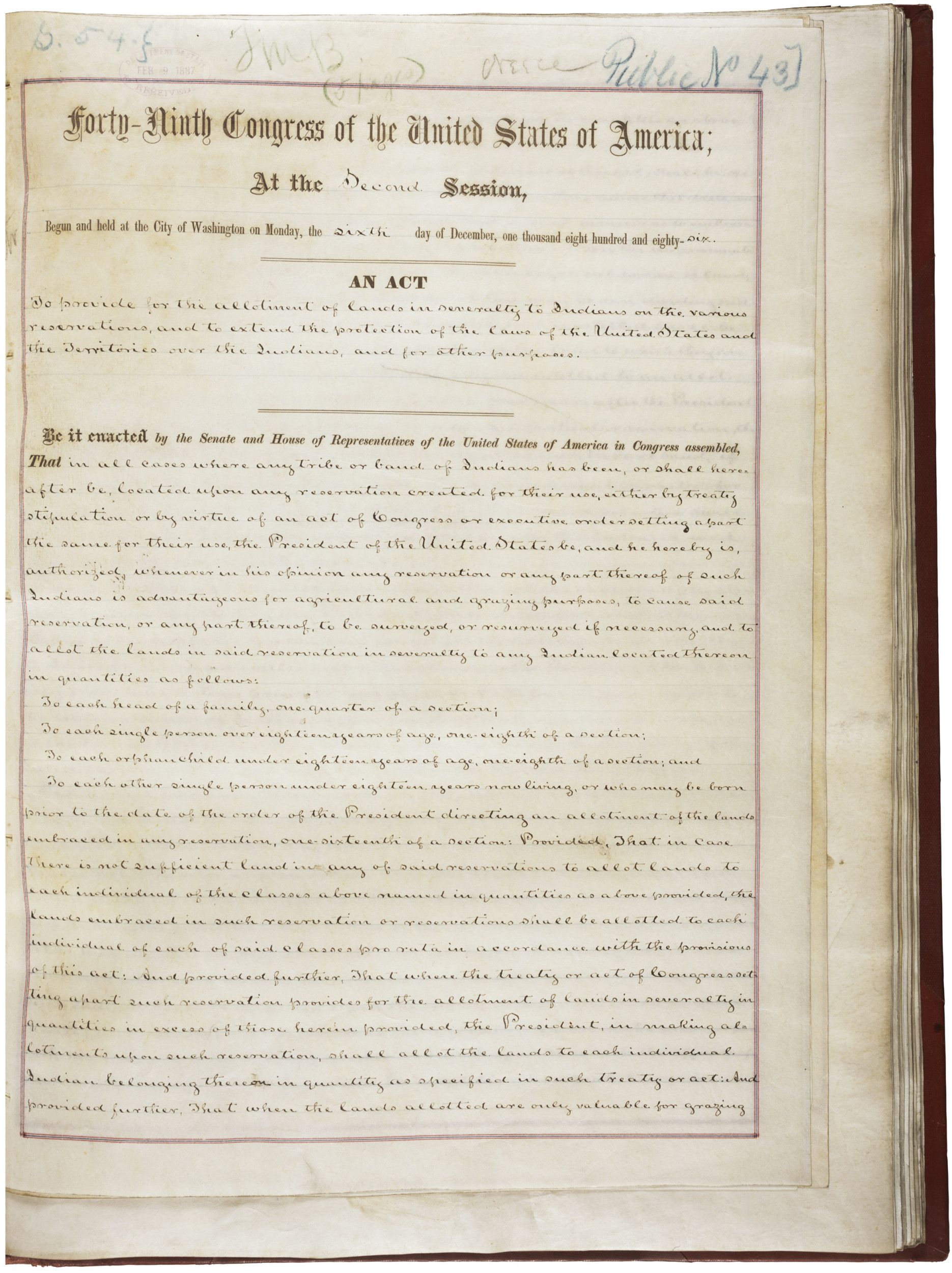
Dawes Act of 1887
Page 2
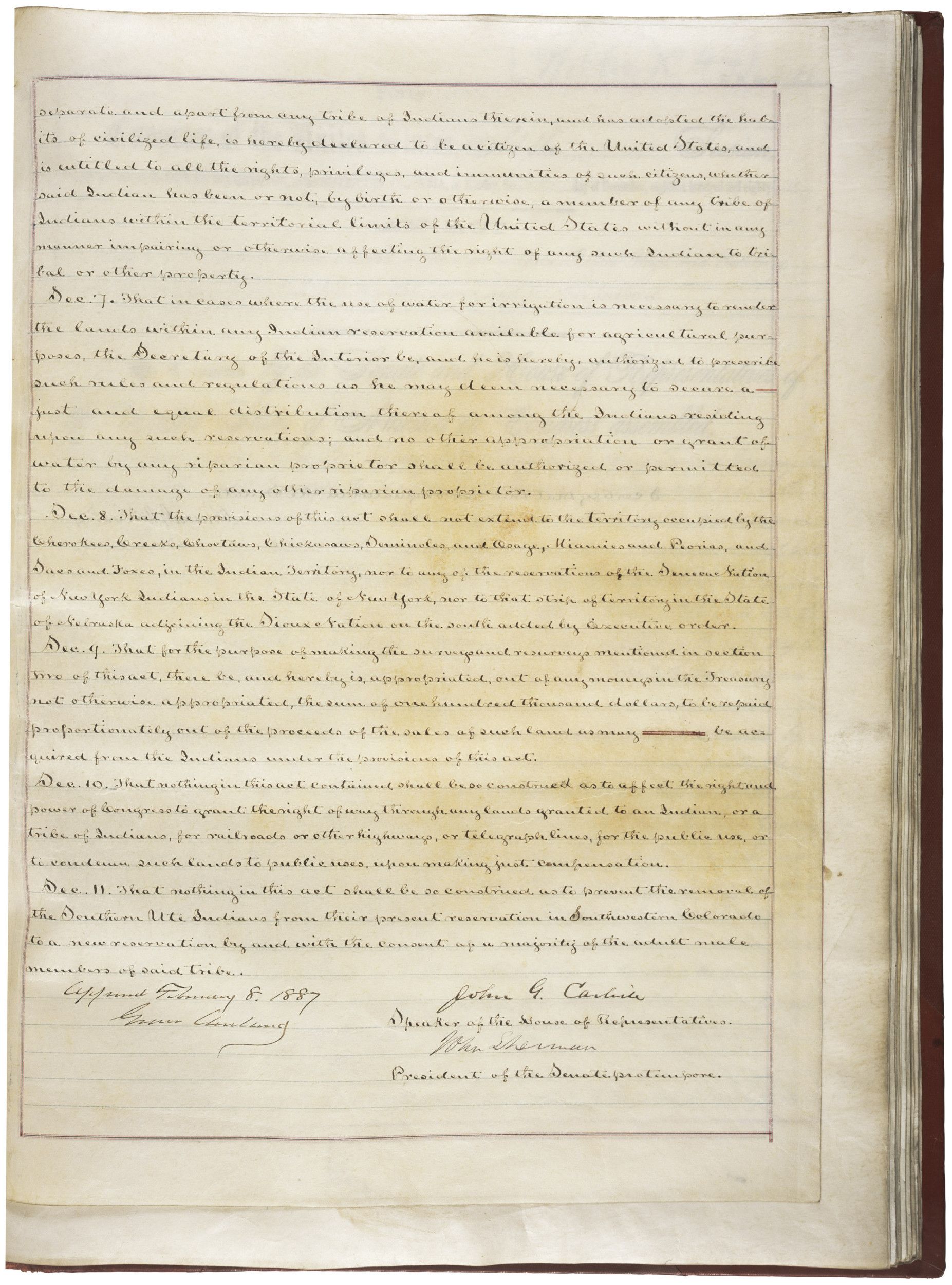
Document
A Hopi (Moqui) Petition Signed by All the Chiefs and Headmen of the Tribe Asking the Federal Government to Give Them Title to Their Lands Instead of Individually Allotting Each Tribal Member.
3/27/1894 - 4/10/1894
The Hopi people of the "Moqui" Villages in the Arizona Territory sent this petition to “the Washington Chiefs" in March, 1894. Signed by all the chiefs and headmen of the tribe, with a symbol for every family, the document asks the federal government to give the Hopi title to their lands instead of individually allotting each tribal member a plot, as had been prescribed by the Dawes Act of 1887. The Moqui worried about losing their matriarchal way of life and cooperative management of resources that helped them adapt to their environment.
Referring to surveyors, the petition said: “During the last two years, strangers have looked over our land with spy-glasses and made marks upon it.…None of us were asked that it should be measured into separate lots, and given to individuals for this would cause confusion.” The document is written in the hand of Thomas Keam, who first came west with the military to move the Navajo people from Arizona to New Mexico, but later established a trading post and worked with Hopi and Navajo leaders to maintain peace between them, new settlers, and American authorities.
Text adapted from “Evaluating Perspectives on Westward Expansion: Weighing the Evidence” in the special "Teaching Difficult Topics with Primary Sources" November/December 2011 issue of the National Council for the Social Studies (NCSS) publication Social Education.
Referring to surveyors, the petition said: “During the last two years, strangers have looked over our land with spy-glasses and made marks upon it.…None of us were asked that it should be measured into separate lots, and given to individuals for this would cause confusion.” The document is written in the hand of Thomas Keam, who first came west with the military to move the Navajo people from Arizona to New Mexico, but later established a trading post and worked with Hopi and Navajo leaders to maintain peace between them, new settlers, and American authorities.
Text adapted from “Evaluating Perspectives on Westward Expansion: Weighing the Evidence” in the special "Teaching Difficult Topics with Primary Sources" November/December 2011 issue of the National Council for the Social Studies (NCSS) publication Social Education.
Transcript
14830 INDIAN OFFICE 1894Inclos. No. 1
No. ..............
[horizontal double lines]
Name: Thomas V. Keam
Rank: Resident Citizen
Station: Keam Cañon
Date: Apl 5 – 1894
Received: Apl 9 – 1894
CONTENTS:
Transmits petition
of Moqui Indians.
Enclo #4
1 st Endorsement
Navajo & Moqui Agency
Fort Defiance A.T.
Respectfully forward
to the Hon Commissioner
of Indian Affairs –
Washington
E.H. Plummer
1st Lt 10th Inf.
Actg Indian Agt
[page 2]
[printed stationery with drawing in upper right corner of Indian woman, head and upper
body, wearing traditional dress, jewelry, and hairstyle]
THOMAS V. KEAM
Tusayan Trading Post,
KEAM’S CAÑON, ARIZONA.
[wavy horizontal line]
Railway and Telegraph Station, Holbrook, Arizona.
14830
Keam’s Canon, Arizona, April 5 1894
1st Lieut E. H. Plummer U.S. Army,
Agent for Navajos
Fort Defiance A.T.
Dear Lieut:
I forward you enclosed a request
of the Moqui Indians, signed by all the Chiefs and head
men of the tribe, (one hundred and twenty three (123)) asking
the Government to give them a title to their land.
Attached are petitions in favour of same, signed by General
A. McD. McCook Commanding the Department, the Officers
of his Staff, General Carr, with Major Powell Director
of Geological Survey, and other prominent citizens
who have visited and are well acquainted with the
character of the Moqui Counrty.
Every family in the tribe is represented on this paper,
and each desired me to make an earnest appeal to you
in their behalf. That you do all in your power for
them, in this most important of all their interests.
Surrounded as they are by a desert with only a few
[page 3]
[printed stationery with drawing in upper right corner of Indian woman, head and upper
body, wearing traditional dress, jewelry, and hairstyle]
THOMAS V. KEAM
Tusayan Trading Post,
KEAM’S CAÑON, ARIZONA.
[wavy horizontal line]
Railway and Telegraph Station, Holbrook, Arizona.
Keam’s Canon, Arizona, .....................189.........
springs miles apart, from which they obtain a scant
supply of water for themselves and their stock, dependent
entirely on the limited rainfall for moisture to raise
their crops; this question is of vital importance to them,
and we hope it will receive favourable consideration
from the Government.
Very truly yours,
Thomas V. Keam.
[page 4]
14830 OFFICE OF 1894
Indian Affairs.
Rec’d APR 19
No. ..............
[horizontal double lines]
Name: E. H. PLUMMER
Rank: ACTING AGENT
Station: NAVAJO AGENCY, N.M.
Date: APR 10 1894
Received:
CONTENTS:
Transmits petition
from Moqui Indians
with other papers, asking
that they be allowed to hold
and cultivate their lands ac-
cording to their own customs.
2 Enlc. File
Allan L
29/145
[page 5]
UNITED STATES INDIAN SERVICE,
N A V A J O Agency,
Fort Defiance, A.T.
April 10, 1894.
14830
Hon. Commissioner of Indian Affairs,
Washington, D.C.
Sir: --
I have the honor to transmit herewith petition of the Moqui
Indians praying that they may be allowed to handle, hold and cil-
tivate their lands according to their customs and that a certain
portion of the reservation be assigned to them exclusively.
I urgently recommend that their request be granted. It is
supported by recommendations of prominent persons familiar with
the life and customs of these people as well as with the lands
which they till.
In a conversation which I had with Special Allotting Agent
John S. Mayhugh, who spent two years or more among these people,
making the surveys preliminary to allotting in severalty of
their lands, he stated to me that from his knowledge of them,
their customs and their land he was of the opinion that it was
a mistake to allot their lands to them in severalty; that such
action was premature with them.
I am sure from what I know of these people and of the allot-
ments that if the allotments are confirmed confusion and trouble
will ensue.
[page 6]
UNITED STATES INDIAN SERVICE,
.............................................Agency,
Some four or five years ago, or more recently, a Commission
was convened, or did convene, at Keam’s Canon, to adjust the mat-
ter of a circle limit, within which the Moquis should have ex-
clusive use of the reservation. There is no record in this office
of the recommendations of this Commission having been confirmed.
Very respectfully,
Your obedient servant,
E. H. Plummer.
1st Lieut. 10th Infantry,
Acting U.S. Indian Agent.
[page 7]
[lines numbered 1-31]
Moqui Villages
Arizona March ^ 27 & 28 ^ 1894
To the Washington Chiefs:
have looked over our lands with spy-glasses
and made marks upon it, and we know but
little of what this means. As we believe that you
During the last two years strangers
have no wish to disturb our possessions, we want
to tell you something about this Hopi land.
None of us ever asked that it should be
measured into separate lots, and given to individuals
for this would cause confusion.
The family, the dwelling house and the field
are inseparable, because the woman is the heart
of these, and they rest with her. Among us the
family traces its kin from the mother, hence
all its possessions are hers. The man builds the
house but the woman is the owner, because she
repairs and preserves it; the man cultivates the
field, but he renders its harvests into the woman’s
keeping, because upon her it rests to prepare the
food, and the surplus of stores for barter depends
upon her thrift.
A man plants the fields of his wife, and
the fields assigned to the children she bears, and
informally he calls them his, although in fact they
are not. Even of the field which he inherits
from his mother, its harvests he may dispose of
at will, but the field itself he may not.
He may permit his son to occupy it and gather
Its produce, but at the father’s death the son may
-1-
[handwritten in brackets upside down at bottom of page] [14830-94]
[page 8]
-2-
[lines numbered 1-31]
not own it, for then it passes to the father’s sister’s
son, or nearest mother’s kin, and thus our fields
and houses always remain with our mother’s family.
According to the number of children
a woman has, fields for them are assigned to
her, from some of the lands of her family group,
and her husband takes care of them. Hence our
fields are numerous but small, and several belonging
to the same family may be close together, or they may
be miles apart, because arable localities are not
continuous. There are some other reasons for the irreg-
ularity in size and situation of our family
lands, as interrupted sequence of inheritance
caused by extinction of families, but chiefly
owing to the following condition, and to which
we especially invite your attention.
In the Spring and early Summer there
usually comes from the Southwest a succession of
gales, oftentimes strong enough to blow away the
sandy soil from the face of some of our fields, and
to expose the underlying clay which is hard, and
sour, and barren; as the sand is the only fertile
land, when it moves, the planters must follow it,
and other fields must be provided in place of those
which have been devastated. Sometimes generations
pass away and these barren spots remain, while
in other instances, after a few years, the winds
have again restored the desirable same upon them.
In such event its fertility is disclosed by the nature
of the grass and shrubs that grow upon it. If
these are promising, a number of us unite to
[page 9]
-3-
[lines numbered 1-31]
clear off the land and make it again fit for
planting, when it may be given back to its former
owner, or if a long time has elapsed, to other heirs,
or it may be given to some person of the same
family group, more in need of a planting place.
These limited changes in land holding are
effected by mutual discussion and concession
among the elders, and among all the thinking
men and women of the family groups interested.
In effect, the same system of holding, and the
same method of planting, obtain among the Tewa,
and all the Hopi villages, and under them we
provide ourselves with food in abundance.
The American is our elder brother, and in
everything he can teach us, except in the method
of growing corn in these waterless sandy valleys,
and in that we are sure we can teach him.
We believe that you have no desire to change our
system of small holdings, nor do we think
that you wish to remove any of our ancient
landmarks, and it seems to us that the
conditions we have mentioned afford sufficient
grounds for this requesting to be left undisturbed.
Further it has been told to us, as coming
from Washington, that neither measuring nor
individual papers are necessary for us to keep
possession of our villages, our peach orchards
and our springs. If this be so, we should like
to ask what need there is to bring confusion into
our accustomed system of holding corn fields.
We are aware that some ten years ago
[page 10]
-4-
[lines numbered 1-31]
a certain area around our lands, was proclaimed
to be for our use, but the extent of this area is
unknown to us, nor has any Agent, ever been able
to point it out, for its boundaries have never
been measured. We most earnestly desire to have
one continuous boundary ring enclosing all the
Tewa and all the Hopi lands, and that it shall
be large enough to afford sustenance for our
increasing flocks and herds. If such a scope can
be confirmed to us by a paper from your hands,
securing us forever against intrusion, all our
people will be satisfied:
[encircled numbers, handwritten names and handdrawn totems of petitioners]
1 Ha’-yi of A’-la [antelope] [rain clouds and lightning] Kwa’-la- Kwai
(Walpi) of
2 (Walpi) O-ku’-wa to’-wa
Ho’-ñi of Tcűa [snake] (Te’-wa)
3 Wű-na’-ta of Pa’-kab 15
(Walpi) [reed] [katcina] Ka’-nű
4 of
Na-syű’ñ- we-ve (Ma’saű űh) [chief] Pa’-kab- nyû-mû
14
of Ko-kop (Walpi) (Walpi)
5
A-na- wi’-ta [rain clouds and lightning]
of
Pát-ki (Sitcomovi) 16
6 Intiwa [katcina] [?] [?]
of Ka-tci’- na 17
(Walpi) [earth’s horizon] Lo-ma’- nak-cű
7 of Tű-wa (Mű-coñ-inovi)
Tű-was’- mi of Pa’-kab
(Walpi) [reed] 18
8 [rat] Pa-lűñ- au-űh
Ha’-ni [tobacco flower] of
of Ka’-la (Cipau’lovi)
Pi’-ba
(Walpi)
9 19
Syűñ-o’- i-ti- wa [katcina] [katcina] Si-kya’- hoñ-ava
of of Katcina
Tca’-kwai- na (Mű-coñ- in-ovi)
(Walpi) 20
10 [parakeet] Kwa’-vi- o-ma
Su’pela [water house] of Gya’-zro
of Pat’-ki (Mű-coñ- in-ovi)
(Walpi) 21
11 [squash]
Kwa’-tca- kwa [rain clouds and lightning] Ta-las’- yau-ma
of of
Pat’-ki Pa’-tûña
(Walpi) (Mű-coñ- in-ovi)
12 22
Tű’-ni- ma [badger] [eagle] [?]
(Sitcomovi) of Ho-na’- ni of
13 Po-la’- ka-ka [maize ear] Kwa’-hű
of Ku-lon- to-wa (Mű-coñ- in-ovi
[page 11]
-5-
[lines numbered 1-31]
[encircled numbers, handwritten names and handdrawn totems of petitioners]
23
[?] [Ma’-sau- űh] Ku-wan’- yűc-va of Ko-kop (Mű-coñ’- in-ovi)
24
(Tewa)
Naquaventiwa [cloud] Na-kwa’- ven-ti- wa of Pat-ki (Műcoñ’inovi)
25
Nuvauanay [badger] Nű-va’- yau-ma of Hon’ani (Mű coñ’inovi)
Kami [parakeet] Ka’-mi of Gya’-zro (Mű-coñ’- in-ovi
26
Shekauleti [bear] Sű-kya’- le-tci- ti-wa of Ho’nauűh (Cipau’lovi)
27
Ushiwa [sun] Kű-wan’- yű’-i- ci-mû of Ta’-wa (Cipaulovi)
28
Shekahpiki [sun] Si-kya’- pi-ki of Ta’-wa (Cipaulovi)
29
Tawahonima [bear] Ta’-wa- hoñi-ma of Hon’auűh (Cipau’lovi)
30
Lamahova [bear] Lo-ma’- hoñ-ava of Hon’auűh (Cipaulovi)
31
Quiwanquaptwa [bluebird] Kű-wan’- kwap-ti- wa of Tca’-ro (Cipaulovi)
32
Shininuwa [katcina] Ta-tcuk’- ti Ci-nai’- ni-wa of Katcina (Cuño’pavai)
33
Hon’ani [rope] of Pi-yű- kűc’ (Hon’-au- űh) (Cuñopavi)
34
Lumaventiwa [bear] Lo-ma’- ven-ti- wa of Hon’-au- űh (Cipaulovi)
35
36
Lololoma [bear] Lo’-lo- lo-ma of Hon’-au- űh (Oraibi)
Conyuniniwa [badger] Ko-yoñ’- ai-ni- wa of Ho-na’- ni (Oraibi)
37
Nuhushi [maize] Nai’-yu- ci-ni-ma of Ka-ű (oraibi)
38
39
Gutagua [badger] Kwa’-tca- kwa of Ho-na’- ni (Oraibi)
[page 12]
-6-
[lines numbered 1-31]
[encircled numbers, handwritten names and handdrawn totems of petitioners]
40 [crane] Sa’-kwai- ma of A-to’- ko (Oraibi)
Shakwama
41 [cloud] Tcos-hoñ’- ni’wa of Pat’ki (Sitco’movi)
Chinon
42 [badger] Ma-cai- yam’-ti-wa of Ho-na’- ni (do)
Mayanitiwa
43 [katcina] Ña’-hű of Tca’-kwai- na (do)
Nayu
[?] [sheep footprints]
44 Sikya’-ven- ti-wa on Pañ’-wa (Ala) (Walpi)
45
Coochventiwa [spruce] Kűtc’-ven- ti-wa of Salab’ (Katcina) (Műcoñ’inovi)
46
Coochcoyono [coyote] Kű-tca’- ko-yo’- ño of I’-sau- űh (ko’-kop) (Műcoñ’inovi)
47
Sa-mi’- wi-ki [cactus] Sa-mi’- wi’ki of Ű’-cű (Tcűa) (Walpi)
48 [snake] Ko’-pű- lű of Tcűa (Walpi)
49 [cloud] Kwa’-a of Pat’-ki (Walpi)
50 [reed] Pau’-wa- ti’-wa
51 [katcina] Sű’-yű- kű
52 [lizard] Ka’-kap’ti of Kű’-kűtc (tű’-wa) Walpi
of Pa’-kab (Walpi)
of Tca’-kwai- na (Walpi)
[page 13]
-7-
[lines numbered 1-31]
[encircled numbers, handwritten names and handdrawn totems of petitioners]
53 [water house over maize] Sa-kwis’- ti-wa of Pat-ki (Walpi)
54 [badger] Yo’-yo- wai-ya of Ho-na’- ni (Sitcomovi)
55 [tobacco] A’-no- ti of Sa-towa (Tewa)
56 [sun] Ka’-la- cai of Tûñ-to- wa (Tewa)
57 [bear] Mo’-tco of Ke-to- wa (Tewa)
58 [snake] Ű’-ű- ya-wa of Hű’-wi (Tcűa group) (Sitcomovi)
[dove]
[page 14]
-8-
[lines numbered 1-31]
[encircled numbers, handwritten names and handdrawn totems of petitioners]
59 [weapon] Nű-va’- ti of Kwi’-ñű- bi (Tca’-kwai- na group) Sitcomovi
60 [bracket] [lizard]
[horizon] Si-kya’- ho’-nau- wû-űh of Kű-kűtc (Tű’-wa group)
[earth mother]
61 [bear] Na-si’- hep-tű- wa of Ho’nau űh (Cûño’pavi)
62 [forehead of sun] Hű-mi’- ñű-i- ti-wa of Ka’-la (Cûño’pavi)
63 [sun] Hon’-co- ha of Ta’-wa (Cipau’lovi)
64 [cloud] Sak-ñű- i-va of Nű’-va (Pat-ki group)
[page 15]
-9-
[lines numbered 1-31]
[encircled numbers, handwritten names and handdrawn totems of petitioners]
65 [bear] Lo-mai’- yam-ti- wa of Ho’-nau- űh (Cûño’pavi)
66 [rope] Hű-mi’-mű- in-i- wa of Ho’-nau- űh (Cipaulovi)
67 [cloud] Lo-mai’- yűc-va of O’-mau- űh (Pat’ki group)
68 [tadpole] Kű-wan’- ma-ca of Pa-va’- ti-ya (Pat’ki group)
69 [cloud] Lo-ma’- ke-le of ^O’mau’űh (Pat’ki group)
70 [bear] Lo-ma’- le-tci- ti-wa of Ho’-nau- űh (Cûño’pavi)
71 [sun] Tű-ve- waih’-ti- wa of Ta’-wa (Cûño’pavi)
72 [maize] Kű-wan’- ho-i- ya-ma of Kaű (Pat-ki group)
73 [water house] Lo-ma’- ho-i- nű-wa of Pat’-ki
(Cûño’pavi)
(Cûño’pavi)
(Cûño’pavi)
(Cûño’pavi)
[page 16]
-10-
[lines numbered 1-31]
[encircled numbers, handwritten names and handdrawn totems of petitioners]
74 [deer] Ha’-ha- wi of So-wi- iñ-wû (Ala) Walpi
From 75 to 123 all are of Oraibi.
75 [badger] Si’-ma of Ho-na’ni
76 [lizard] Wik’-vai- ya of Pa-tcib’- kwa-ca; Tű’-wa group.
77 [badger] Poñ-ya’- mű-in- i-wa of Ho-na’- ni
78 [lizard] Na-wi’- ni of Ma’-tca- kwa; Tű’-wa group
79 [bow] Lo-ma’- nim-ti- wa of Au’-i- ta of Pa’-kab group.
80 [bow] Nű-ci’- ti-ma of Au’-i- ta; Pa’-kab group.
[page 17]
-11-
[lines numbered 1-31]
[encircled numbers, handwritten names and handdrawn totems of petitioners]
81 [sun] Kű-ya- yep’-ti- wa of Ta’-wa; Pa’-kab group.
82 [sun] Ta-las- kwap’-ti- wa of Ta’-wa
83 [rattlesnake] Kűk’-ti- wa of Tcűa
84 [bear] Cak-hoñ’- yo-ma of Ho’nauwûűh.
85 [rattlesnake] Na-mu’- ra of Tcűa
86 [reed] Lo-man’- kwa of Te’-be; Pa’-kab group.
87 [rabbit] Tañ-ak’- wai-ma of Ta’-bo.
88 [reed] Si’kya’-hoñ-yo- ma of Pa-ka- bi
89 [katcina] Si-kya’- mű-in- i-wa of Katcina (Ta-tcuk’- tű)
90 [coyote] Lo-ma’- ta-wa of i’-sau- űh; Ko-kop group
91 [earth] Ma-ca’- to-i- ni-wa of Tű’-wa
92 [hare footprint] Kű-wan’- wai’-ti- wa of So’-wi; Ta’-bo group
Totem is So-wi’- kű-kű.
[page 18]
-12-
[lines numbered 1-31]
[encircled numbers, handwritten names and handdrawn totems of petitioners]
93 [tobacco] Na-kwa’- yec-ti- wa of Pi’-ba
94 [Ma’-sau- űh] Tañ-ak- nim-ti- wa of Ma’-sau- űh; Ko’-kop group.
95 [bear] Tű-wa’- ho-yo- ma of Ho’-nau- wû-űh
96 [Ma’-sau- űh] Kű-wan’- wai-yo- ma of Ma’-sau- űh; Ko’-kop group.
97 [bear] Lah’-pű of Ho’-nau- wû-űh
98 [squash blossom] Ta-las- nűm’-ti- wa of Pa’tûñ-a: Totem is patûñ-ci
99 [butterfly] Kű-wan- wai’-ni- wa of Bo’-li; Ho-na’- ni group.
100 [tobacco flower] Ta-las- yam’-ti- wa of Pi’-ba
101 [eagle] Ta-las’- ve-ma of Kwa’-hű; Pa’-kab group.
102 [reed] Kwű-ma’yeo’- ti-wa of Pa’-ka-bi
103 [reed] Na-ci’- to-i- ni-wa of Pa’ka-bi
104 [katcina] Si-ma’- i-ti- wa of Katcina
(Totem is A’-ho- li)
[page 19]
-13-
[lines numbered 1-31]
[encircled numbers, handwritten names and handdrawn totems of petitioners]
105 [snake] Tű’ve-yam’- ti-wa of Tcűa
106 [rope] Ta-wa- kwap’-ti- wa of Pi’-yű- kűc; Ho’nauwûűh group.
107 [rabbit] Ma-ca’- ve-ma of Ta’-bo
108 [lizard] Hű-mi- hoi’-ni- wa of Kű’-kűtc; Tű’-wa group.
109 [snake] Lo-mai’- yes-va of Tcűa
110 [coyote] Tű-ve- yec’-ti- wa of I’-sau- űh; Ko’-kop group.
111 [sun] Kel-hoñ’- ni-wa of Ta’-wa; Pa’-kab group.
112 [katcina] Ma-ca- hoñ’-ava of Katcina
(Totem is Ta’cab)
[page 20]
-14-
[lines numbered 1-31]
[encircled numbers, handwritten names and handdrawn totems of petitioners]
113 [crane] Tű-wa- hoi’-ni- wa of A-to’- ko
114 [cloud] Lo-ma- hoi’-ni- wa of O’-mau- űh; Pat’-ki group.
115 [lizard] Nű-va’- ve-ma of Kű’-kűtc; Tű-wa group.
116 [pigeon-hawk] Ta-las- ven’-ti- wa of Ke’-le
117 [cloud] Kű-wan’- yu-wa of O’-mau- űh
118 [reed] Ci-kai- yec’-ti- wa of Te’-be
119 [badger] Kwű-ma- hoi’-ni- wa of Ho-na’- ni.
120 [reed] Bo-li- yec’-ti- wa of Te’-be
121 [lizard] So-wi’- wa of Kű’-kűtc (Ma’-tca- kwa) Tű-wa group.
122 [badger] Cak’-wű- nű of Ho-na’- ni
123 [earth’s horizon] Lo-ma- ac’-ni- wa of Tű-wa.
[page 21]
14½
[lines numbered 1-31]
Sitcomovi, March 27th , 1894.
I certify that I understand the foregoing petition
and that I have told its meaning to the people of the East
mesa and of the Middle mesa.
Susie Pitei
I certify that I understand the foregoing petition
and that I have told its meaning to the people of the
Middle mesa and of Oraibi.-- -- -
Bitcomovi
March 28th , 1894 [bracket] [badger] Ma-cai- yam’-ti- wa
[signed] AM Stephen, Witness
[signed] AM Stephen
[signed] Thomas V. Keam
[signed] H.R. Voth
[page 22]
-15-
[lines numbered 1-31]
Memorandum; Explaining the foregoing Totem signatures.
All of the signers are principals in the primitive Religious
Societies, are eldest brothers (Chiefs) of gentes, Chiefs of
Villages, or otherwise commonly recognized as typical
Representatives of the Hopi and Tewa peoples.
No. 1. Antelope. The signer is of the Antelope gens of the Horn group of gentes:
he signs for his nephew, the Village Chief of Walpi, a young man,
not yet considered to have sufficient experience to take active part
in public affairs of importance.
2. Snake. The signer is of this group of gentes, and is Announcement Chief,
or Orator, of Walpi.
3. Reed. The signer is of this group of gentes, and is one of two Chiefs of the
“Horn”, one of the four principal religious societies.
4. Ma’-sau- wû-űh; A chief conception, believed to preside over metamorphic
and other mundane transformations, and especially over Fire and
Death. The gens of the signer is named after this deity, and
belongs to the group of gentes called “Ko’-kop” = All fuels. The
signer wishing to make his totem clearer drew the larger figure of
Ma’sauwûűh.
5. Rain Clouds and Lightning perched over a growing plant of maize; it is the
totem of a large number of gentes united under the common
term of Pat’-ki – Water-house, or Moisture people. The signer
is Chief of the “Agave people”, one of the four principal religious
societies.
6. Ka-tci’- na. A conception of numerous superhuman beings who are inter-
mediaries between the people and their deities. There are a
number of gentes named after these mythic beings and their
belongings, and the totem here displayed is the mask of the
He-he’- ya Katcina, an occult personage deemed of great virtues.
The signer is Chief of the most important Katcina rites.
7. Reed; same as No 3. The signer is the other Chief of the “Horn” society.
8. The flower of an indigenous species of tobacco, called pi’-ba, the name of
the signer’s gens; he is Chief of the “Dawn Singers” one of the
four principal religious societies.—
[page 23]
-16-
[lines numbered 1-31]
9. Tca’-kwai- na, a Warrior Katcina after which was named a group of Tewa
gentes, now incorporate with the Hopi; the totem represents the mask
worn by the personators of this Katcina at certain ceremonies. The
signer is Chief of the “Thinkers” one of the four principal religious
societies.
10. Water-house, same as No 5.
11. Rain clouds & lightning; the signer is of the Cloud gens of Water-house group.
12. Badger. The signer is of the Badger gens, the totem is badger feet.
13. An ear of maize; the signer is of the Maize gens of the Tewa people.
14. Rain clouds & lightning; the signer is of Cloud gens of the Tewa people.
15. Represents a stone figurine of the war deity, which fetich is in the keeping
of the Reed group of gentes to which the signer belongs.
16. Indistinct. The man who tried to draw his totem here belonged to the same
group of gentes as at No 4; although he was mortally ill he was anxious to
set his mark to the petition, and he died upon the following day.
17. The signer belongs to the Earth, or Land, group of gentes, and the totem
he uses is the circle, the horizon, encompassing the Hopi region.
18. This is of rather curious interest as showing the signer’s erroneous conception
of the meaning of the name of his own gens, which is Ka’-la, of the
Reed group of gentes. Ka’-la means rat, and it also means
forehead; the signer has taken the former meaning and has tried to
depict a rat; but actually there is no “rat” gens, there is, however,
a forehead (of the sun) gens, the proper totem of which appears at No 62.
19. Ka-tci’- na; the totem crudely represents the mask of a personage called
“Broad-face”, one of the conceptions of the terrible.
20. Parroquet; the signer has tried to depict this bird, which is the name
of his gens, and belongs to the Katcina group of gentes.
21. Squash; the totem represents the vegetable. This gens long extinct on the East
mesa.
22. Eagle; a crude convention; a gens pertaining to the Reed group.
23 An abortive attempt to depict a totem similar to No 4.
24 Cloud. See No 11.
25 Badger. “ No 12.
26 Parroquet “ 20.
[page 24]
-17-
[lines numbered 1-31]
27. Bear. The signer belongs to this group of gentes and as a totem depicts a bear’s
foot.
28 Sun. This totem is the conventional figure of the Sun, a gens in the Reed group.
29 Sun. See No. 28.
30. Bear. “ “ 27.
31 Bear “ “ 27.
32. The signer belongs to the Blue-bird gens of the Bear group; he attempts to
depict this bird.
33. The signer is of the Katcina group of gentes, and for a totem has depicted the
cowl mask, studded with seed stuffed knobs, peculiar to the Ta-tcuk’- tű,
a phrase description of this Knob mask. These Ta-tcul’- tű are an
improvised group of men who don these masks, stain their bodies with
ochre, and accompanied by a drummer, sing as a chorus, before which
the Katcina personalities dance at certain exhibitions.
34. This totem is the pi’-yű- kű-ca, carrying rope made of bear’s skin, with a
ring fastened to its end. A gens of the Bear group took its name from
the mythic circumstances attending the making of the first of these ropes.
35 Bear. See No 27.
36 Bear. “ “ The signer is the Village Chief of Oraibi.
37 Badger. “ 12.
38 Maize. The signer belongs to the Maize [struckthrough] gens, of the Water-house
group, and depicts an entire growing plant of maize.
39 Badger. See No 12.
40 Crane. The signer belongs to Crane gens and tried to depict a flying
Crane.
41. Cloud. See No 11.
42 Badger. See No 12.
43 Tca’-kwai- na. This totem is the mask of the “Warrior Grandmother”
of this group of gentes; the mask is worn by personators of this
Katcina at certain annual ceremonies.
44. Mountain sheep footprints; the signer belongs to the Mountain
sheep gens of the Horn group.
45. Spruce tree; The boughs and foliage of the Spruce are devoted to many
sacred purposes in connection with ceremonies and Katcina
exhibitions. The signer is of the Spruce gens of the Katcina group.
[page 25]
-18-
[lines numbered 1-31]
46. Coyote. The signer is an old man, quite stone blind, and one of his
friends helped him by guiding his hand as he drew the Coyote head;
he is of the Coyote gens, of the Ko’-kop group of gentes.
47. Columnar Cactus; the signer belongs to a gens of that name, of the
Snake group of gentes.
48. Snake. This convention is common to the entire group of Snake
gentes. Nos. 47 and 48 are the two Chiefs of the Walpi Snake Ceremonies.
49. Cloud. See No 11.
50. Reed. See No 15. This reed (phragmites communis) is held sacred
because its prototype was the mythic plant up which all mankind
climbed from the Underworld. The signer, by inheritance, is
the Keeper of the War fetiches.
51. Tca’-kwai- na. See No 9.
52 Lizard. The signer is of the Lizard gens, of the Earth group of gentes.
53. Water-house. See No 5.
54. Badger. The signer depicts the totem for the first mythic badger who came
from the Underworld, carrying a bundle on its back which
contained all medicinal charms, and in its left hand, the excorcising
wing feather of the Buzzard.
55. Tobacco. This totem was drawn by the Tewa Chief of this gens,
and depicts the same plant as that of which the Walpi Chief
drew the flower; see No 8.
56. Sun; the signer is the Tewa Sun-priest, and the sole survivor of the
Tewa Sun gens.—
57. Bear. The signer is the Chief of the Tewa Bear gens.
58. The signer depicts the Dove, which is his gens, and the Snake,
the group of gentes to which it belongs.
59. The pűtc’-ko- hű (thin-wood) here depicted is a boomerang shaped
weapon, always made of Oak, the gens of the signer; the Oak
is if the Tca’-kwai- na group of gentes.
[page 26]
-19-
[lines numbered 1-31]
60. The signer of this rather elaborate totem belongs to the Lizard gens, of the
Earth group; he depicts the specific lizard after which his gens is
named; the oval marks represents the horizon, the ideal boundary
of the Hopi earth, and the uncouth figure is a recognized con-
vention of the Earth-Mother, and is the female complement
of the deity Ma’-sau- wû-űh, referred to in No 4.
61. Bear. The signer is of that gens and depicts a conventional bear’s foot;
he is Village Chief of Cûño’pavi.
62. Ka’-la, = Forehead (of the Sun); the earliest sunlight, from the yet
only half risen sun, is regarded as of special beneficence, The
signer is of this Forehead gens, and is of the group including Sun and Reed.
63 Sun. See No 28.
64 The signer is of the Snow gens of the Water-house group, and depicts the
typical Cloud totem of these gentes.
65. Bear. See No 27.
66. This totem is of a gens called Ña’-ta, of the Bear group, and represents
the widened part of the bear’s skin rope, against which the forehead
is pressed, when the rope supports a burden upon the back.
67. Cloud. See No 11.
68. Tadpole. The signer is of Tadpole gens of the Water-house group.
69 Cloud. See No 11.
70 Bear. “ 27
71 Sun “ 28
72 Maize “ 38
73 Water-house “ 5
74 Deer. The signer is of Deer gens of the Horn group.
75 Badger; See No 12.
76 Lizard; The signer depicts the specific lizard after which his gens is named.
77 Badger. See No 12
78 Lizard. The signer depicts a conventional figure of the Horn-toad after
which his gens is named.
From No 75 all the signers are of Oraibi.
[page 27]
-20-
[lines numbered 1-31]
79 Bow; The signer is of Bow gens, of the Reed group.
80 Bow; See No 79.
81 Sun; [bracket joining 81 and 82] See No 28
82 Sun;
83 Rattlesnake, a gens of the Snake group.
84 Bear; See No 27
85 Rattlesnake, See No 83.
86 Greasewood (sarcobatus verm.0 a gens of the Reed group.
87 Cottontail rabbit; a group of gentes, called the Rabbit, is composed of
this Cottontail gens, and another called after the jackass rabbit, or hare.
88 Reed; See No 50.
89 Katcina; See No 33.
90 Coyote, of the “All fuels” group of gentes.
91 Earth, See Nos. 17 and 60.
92 The signer is of Jackass rabbit gens and the totem represents
the footprints of this large rabbit, or hare.
93 Tobacco. See Nos. 8 and 55.
94 Ma’-sau- wû-űh; The signer is of this gens, of the “All fuels” group,
and for totem depicts the mask worn by the personator
of this deity at one of the winter ceremonies.
95 Bear; See No 27
96 Ma’-sau- wû-űh; See No 94.
97 Bear; See No 27.
98 Squash blossom; this is a very common convention; the signer is of Squash
gens.
99. Butterfly; the signer is of Butterfly gens, of the Badger group.
100 Tobacco; See Nos. 8, 55 & 93.
101. Eagle; the signer is of Eagle gens, of Reed group, & depicts an Eagle’s foot.
102 Reed; See No 50
103 Reed; See No 50
104 Katcina; The signer depicts the mask of the personators of A’-ho- li Katcina.
105. Snake; The signer is of Rattlesnake gens, of the Snake group.
[page 28]
-21-
[lines numbered 1-31]
106 Bear skin rope; See No 34.
107 Cottontail rabbit; See No 87.
108 Lizard; See No 52.
109 Snake; See No 105.
110 Coyote; See No 90
111 Sun; “ “ 28
112 Katcina; The signer depicts the mask of the personators of Ta-cab’ Katcina.
113 Crane; See No 40.
114 Cloud; “ “ 11
115 Lizard “ “ 52
116 Pigeon-hawk; The signer has tried to depict this small hawk and its
footprint.
117. Cloud; See No 11
118 Greasewood; “ “ 86
119 Badger; “ “ 12
120 Greasewood; “ “ 86
121 Lizard; “ “ 78
122 Badger; “ “ 12
123 Earth; “ “ 17 and 60.
[page 29]
-22-
[lines numbered 1-31]
We the undersigned are informed that
the Moqui Indians of Arizona are asking
the Government to grant them a title in
common, to the area of land they occupy, and
we would gladly endorse their petition for such
purpose.
The forbidding physical features of
this region, a desert scope of shifting sand dunes
and waterless valleys, led these people to evolve
peculiar but effective methods of field culture, and
for ages they have kept themselves in plenty.
We understand that they have many
ancient land owning customs, under which they
still hold their dwellings and planting grounds:
the system seems well adapted to their circumstances,
and as they are anxious to preserve it, we see no
reason why they should be interfered with.
As all of the other village Indians of New
Mexico have their lands confirmed to them, we
think that in justice, these Moquis should also
have the scope they occupy similarly confirmed,
as they have been in possession since the
Spanish conquest.
We have visited these interesting people,
and noted their surroundings, and can testify as
to their habits of laborious industry, and their
perseverance against formidable natural obstacles.
We therefore hope their petition for title will
receive favourable consideration from the
Government, so that these remote people
may continue to maintain themselves, happily
[page 30]
-23-
[lines numbered 1-31]
and in prosperous independence.
[signed] A. McD. McCook
Brig Genl U S Army
Commanding Dept. of the Colorado
Chauncey B. Baker
1st Lieut. 7th Infty Aide de Camp
John E. McMahon
I Lieut. 2 Arty, Aide de Camp.
A C Sharpe Captain USA
Thomas Ward
Lt Col. & Asst. Adjt. Genl.
Charles L. Collins
1st Lieut 11th Infantry
[illegible]
Gen. McCook & others
Recommends
granting of request
of Moquis—
Encl 2.
[page 31]
-24-
[lines numbered 1-31]
We the undersigned are informed that
the Moqui Indians of Arizona, are asking the
Government to grant them a title in common
to the area of land they occupy, and we would
gladly endorse their petition for such purpose.
The forbidding physical features of this
region, a desert scope of shifting sand dunes and
waterless valleys, led these people to evolve peculiar
but effective methods of field culture, and for
ages they have kept themselves in plenty.
We understand that they have many ancient
land owning customs under which they still
hold their dwellings and planting grounds: the
system seems well adapted to their circumstances,
and as they are anxious to preserve it, we see no
reason why they should be interfered with.
As all of the other village Indians of New
Mexico have their lands confirmed to them, we
think that in justice, these Moquis should also
have the scope they occupy similarly confirmed,
as they have been in possession since the Spanish
conquest.
We have visited these interesting
people, and noted their surroundings, and can
testify to their habits of laborious industry, and
their perseverance against formidable natural
obstacles.
We therefore hope their petition for title
will receive favorable consideration from the
Government, so that these remote people may
continue to maintain themselves, happily and
[page 32]
-25-
[lines numbered 1-31]
in prosperous independence.
James Mooney
Frank Hamilton Cushing
James Dorsey
Gilbert Thompson
A H Thompson
Arthur P. Davis
E.M. Douglas
H M Wilson
J.K. Hillers
H.C. Rizer
William Hallett Phillips
[illegible]
Eugene A. Carr Bvt. Maj. Gen’l.
14830 INDIAN OFFICE 1894
Inclos. No. 2
James Mooney & others
Recommends
approval of Moqui
petition
Encl. #3
This primary source comes from the Records of the Bureau of Indian Affairs.
National Archives Identifier: 300340
Full Citation: A Hopi (Moqui) Petition Signed by All the Chiefs and Headmen of the Tribe Asking the Federal Government to Give Them Title to Their Lands Instead of Individually Allotting Each Tribal Member.; 3/27/1894 - 4/10/1894; Letters Received, 1881 - 1907; Records of the Bureau of Indian Affairs, ; National Archives Building, Washington, DC. [Online Version, https://docsteach.org/documents/document/hopi-petition, April 20, 2024]A Hopi (Moqui) Petition Signed by All the Chiefs and Headmen of the Tribe Asking the Federal Government to Give Them Title to Their Lands Instead of Individually Allotting Each Tribal Member.
Page 1
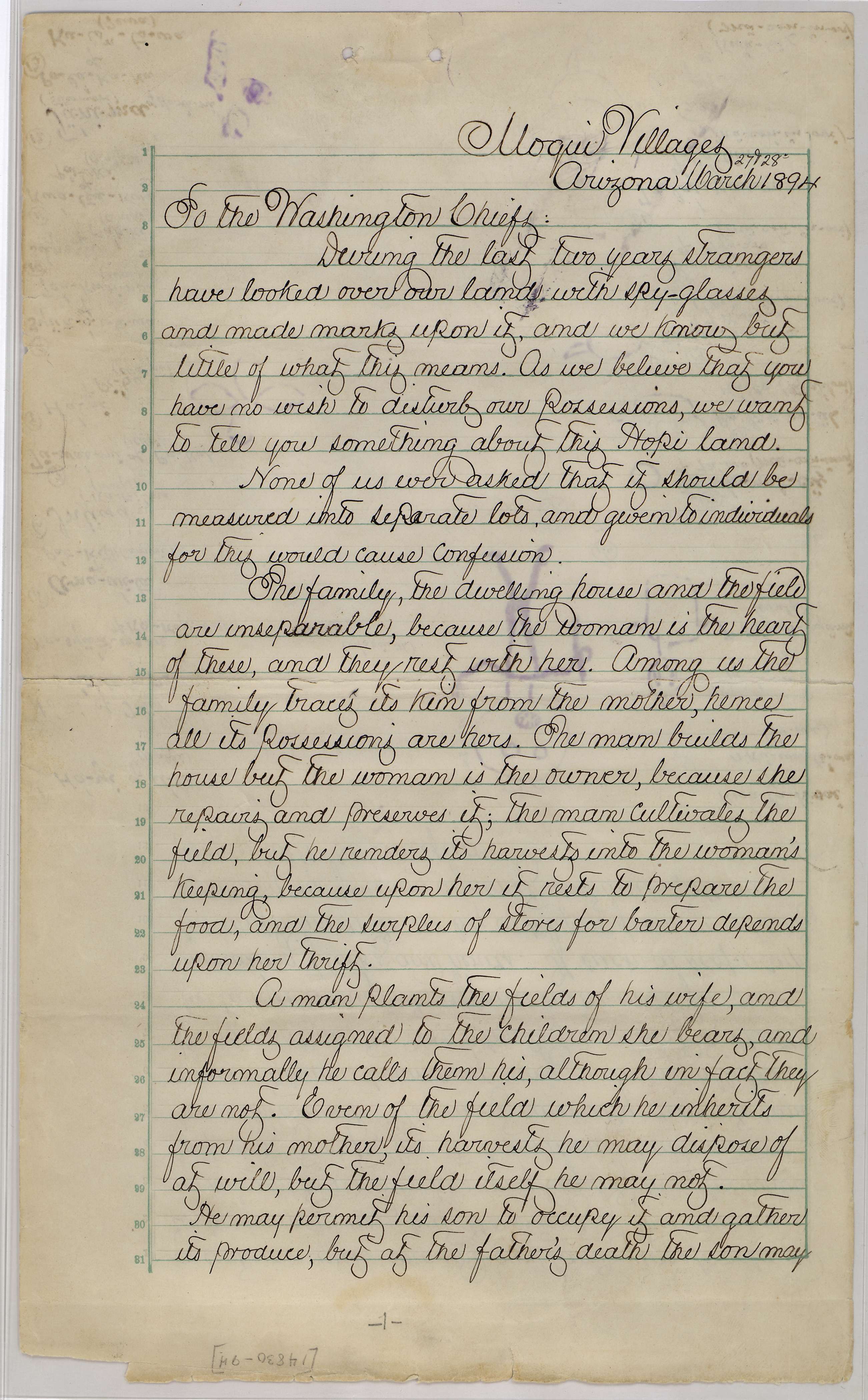
A Hopi (Moqui) Petition Signed by All the Chiefs and Headmen of the Tribe Asking the Federal Government to Give Them Title to Their Lands Instead of Individually Allotting Each Tribal Member.
Page 3
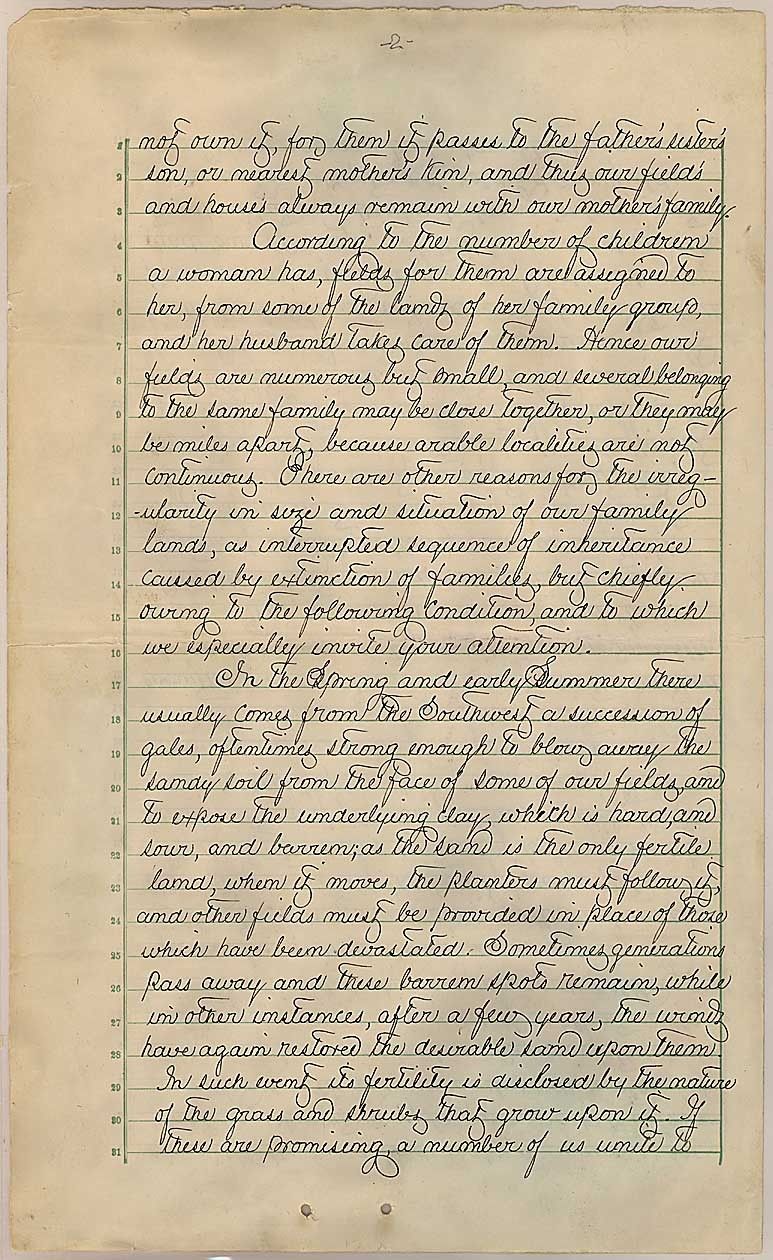
A Hopi (Moqui) Petition Signed by All the Chiefs and Headmen of the Tribe Asking the Federal Government to Give Them Title to Their Lands Instead of Individually Allotting Each Tribal Member.
Page 4
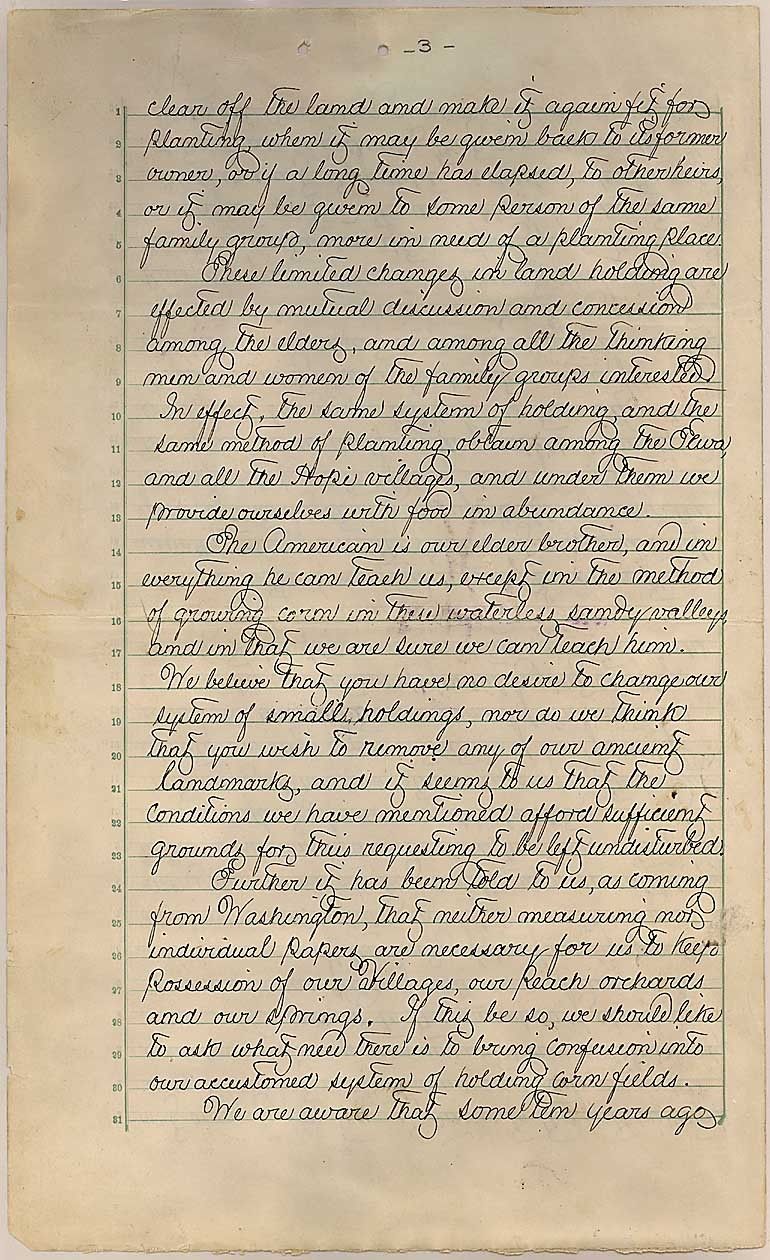
A Hopi (Moqui) Petition Signed by All the Chiefs and Headmen of the Tribe Asking the Federal Government to Give Them Title to Their Lands Instead of Individually Allotting Each Tribal Member.
Page 5

A Hopi (Moqui) Petition Signed by All the Chiefs and Headmen of the Tribe Asking the Federal Government to Give Them Title to Their Lands Instead of Individually Allotting Each Tribal Member.
Page 6

A Hopi (Moqui) Petition Signed by All the Chiefs and Headmen of the Tribe Asking the Federal Government to Give Them Title to Their Lands Instead of Individually Allotting Each Tribal Member.
Page 7
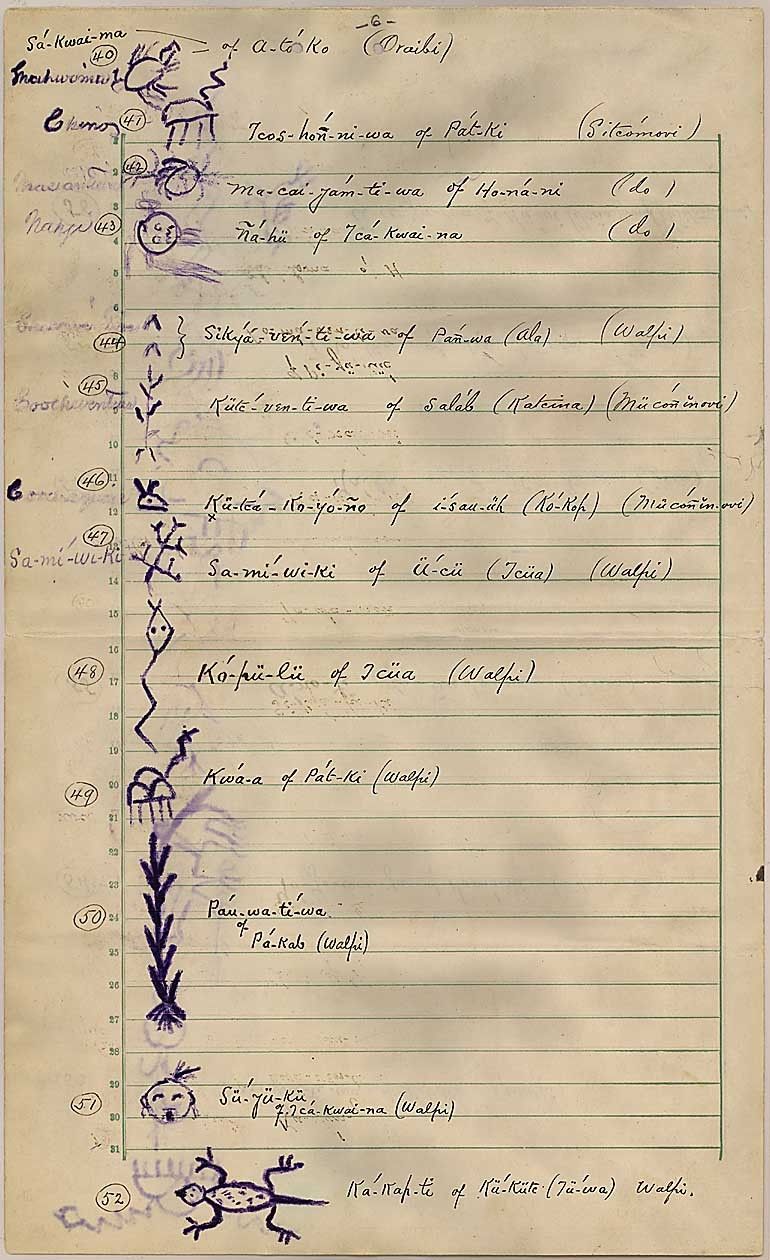
A Hopi (Moqui) Petition Signed by All the Chiefs and Headmen of the Tribe Asking the Federal Government to Give Them Title to Their Lands Instead of Individually Allotting Each Tribal Member.
Page 8
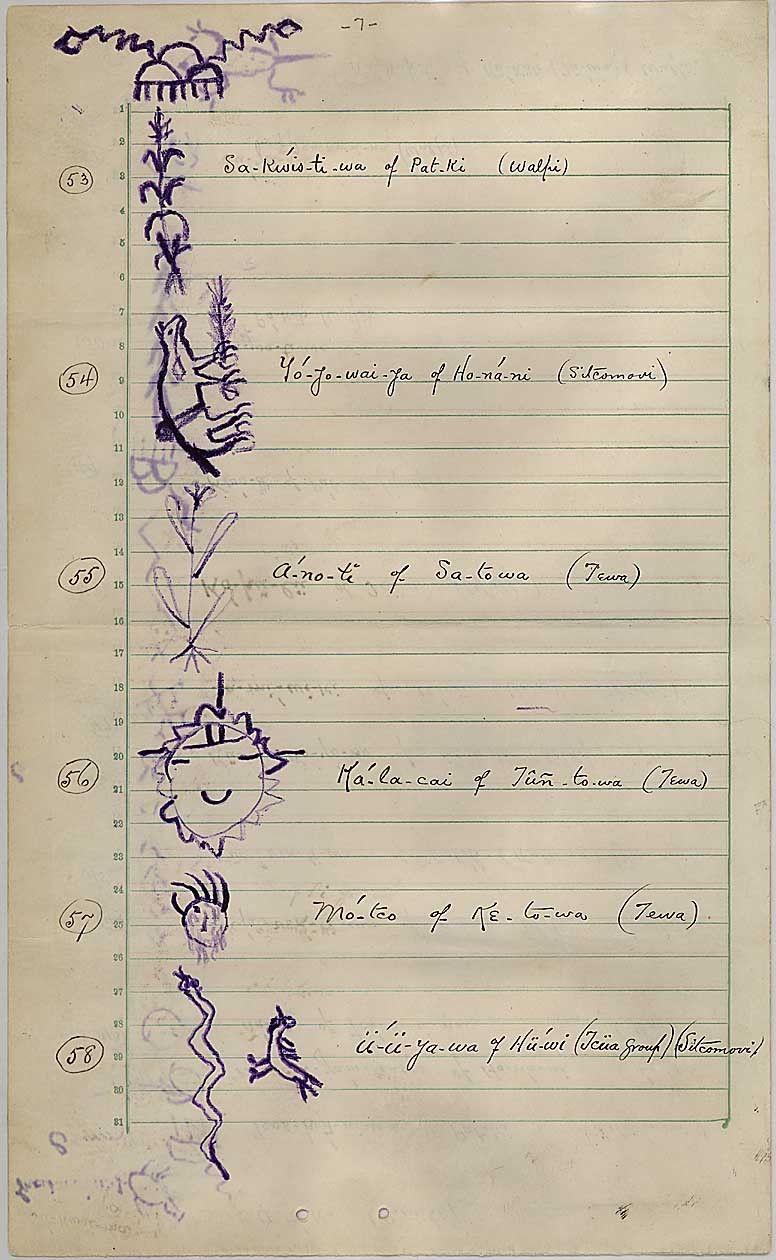
A Hopi (Moqui) Petition Signed by All the Chiefs and Headmen of the Tribe Asking the Federal Government to Give Them Title to Their Lands Instead of Individually Allotting Each Tribal Member.
Page 9
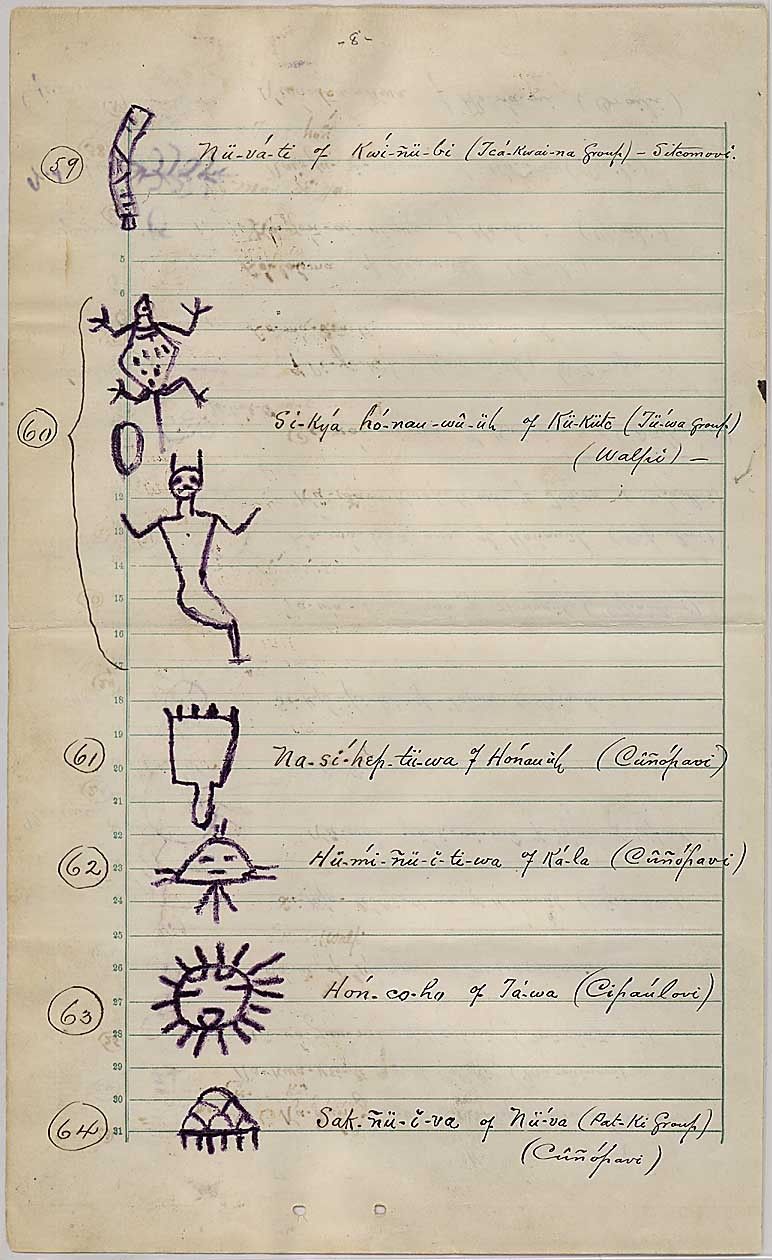
A Hopi (Moqui) Petition Signed by All the Chiefs and Headmen of the Tribe Asking the Federal Government to Give Them Title to Their Lands Instead of Individually Allotting Each Tribal Member.
Page 10

A Hopi (Moqui) Petition Signed by All the Chiefs and Headmen of the Tribe Asking the Federal Government to Give Them Title to Their Lands Instead of Individually Allotting Each Tribal Member.
Page 11
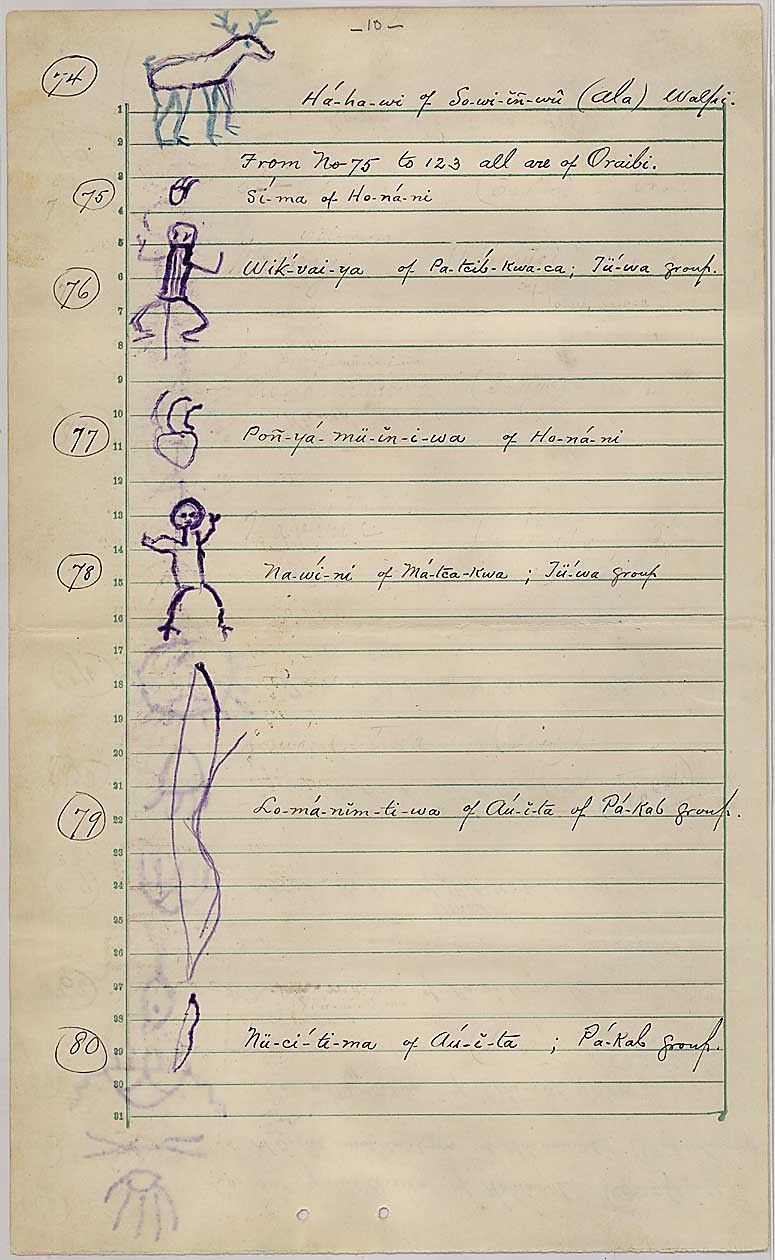
A Hopi (Moqui) Petition Signed by All the Chiefs and Headmen of the Tribe Asking the Federal Government to Give Them Title to Their Lands Instead of Individually Allotting Each Tribal Member.
Page 12
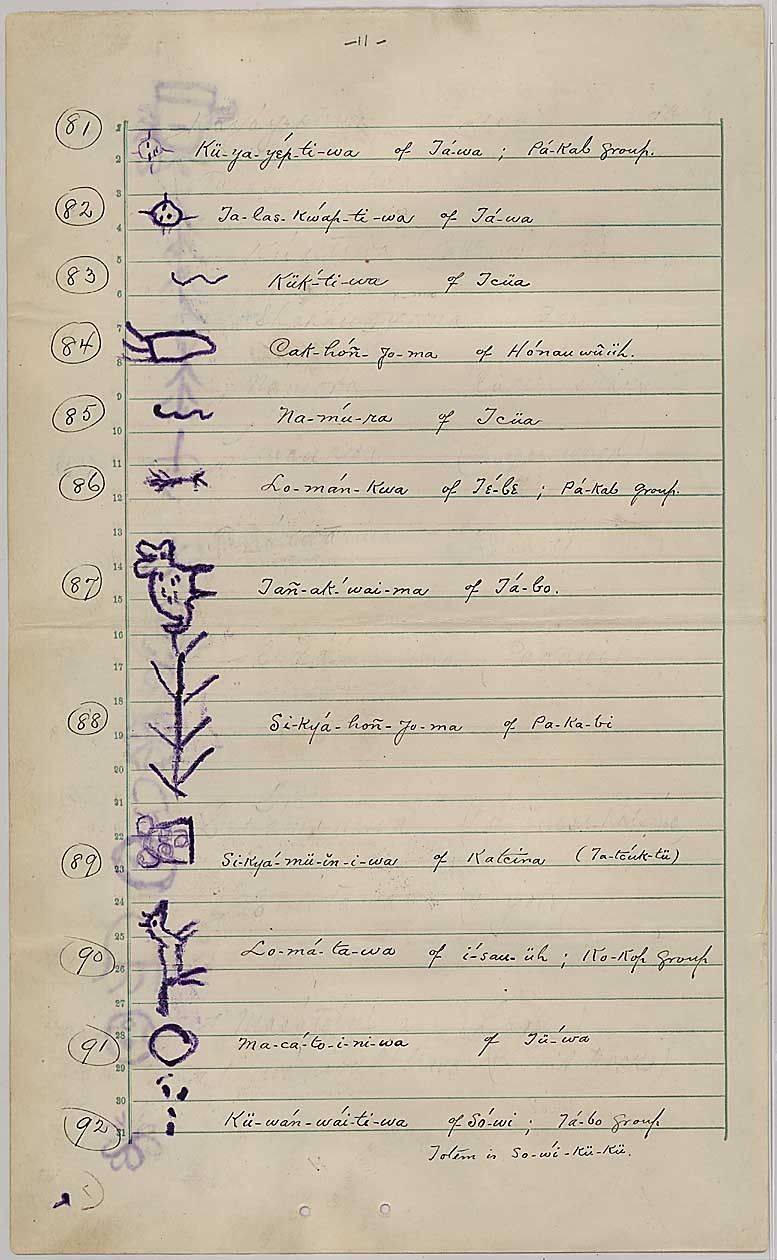
A Hopi (Moqui) Petition Signed by All the Chiefs and Headmen of the Tribe Asking the Federal Government to Give Them Title to Their Lands Instead of Individually Allotting Each Tribal Member.
Page 13
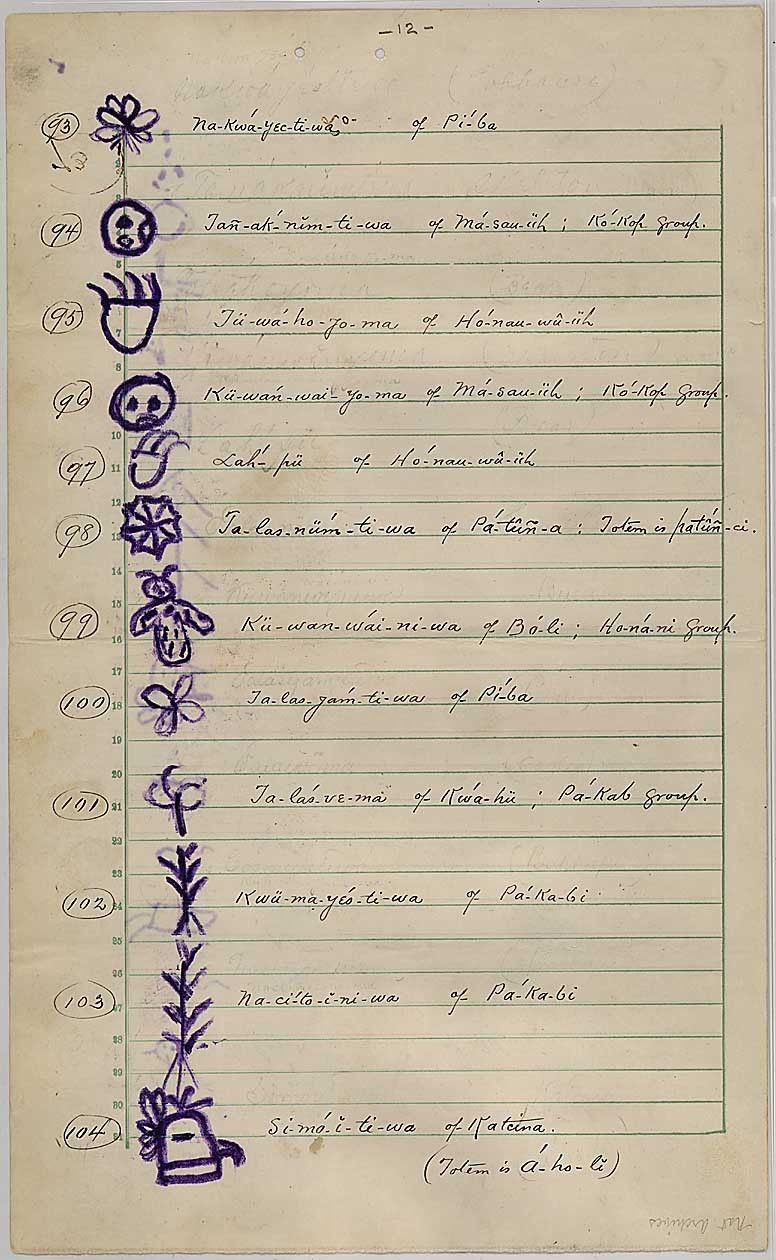
A Hopi (Moqui) Petition Signed by All the Chiefs and Headmen of the Tribe Asking the Federal Government to Give Them Title to Their Lands Instead of Individually Allotting Each Tribal Member.
Page 14

A Hopi (Moqui) Petition Signed by All the Chiefs and Headmen of the Tribe Asking the Federal Government to Give Them Title to Their Lands Instead of Individually Allotting Each Tribal Member.
Page 15
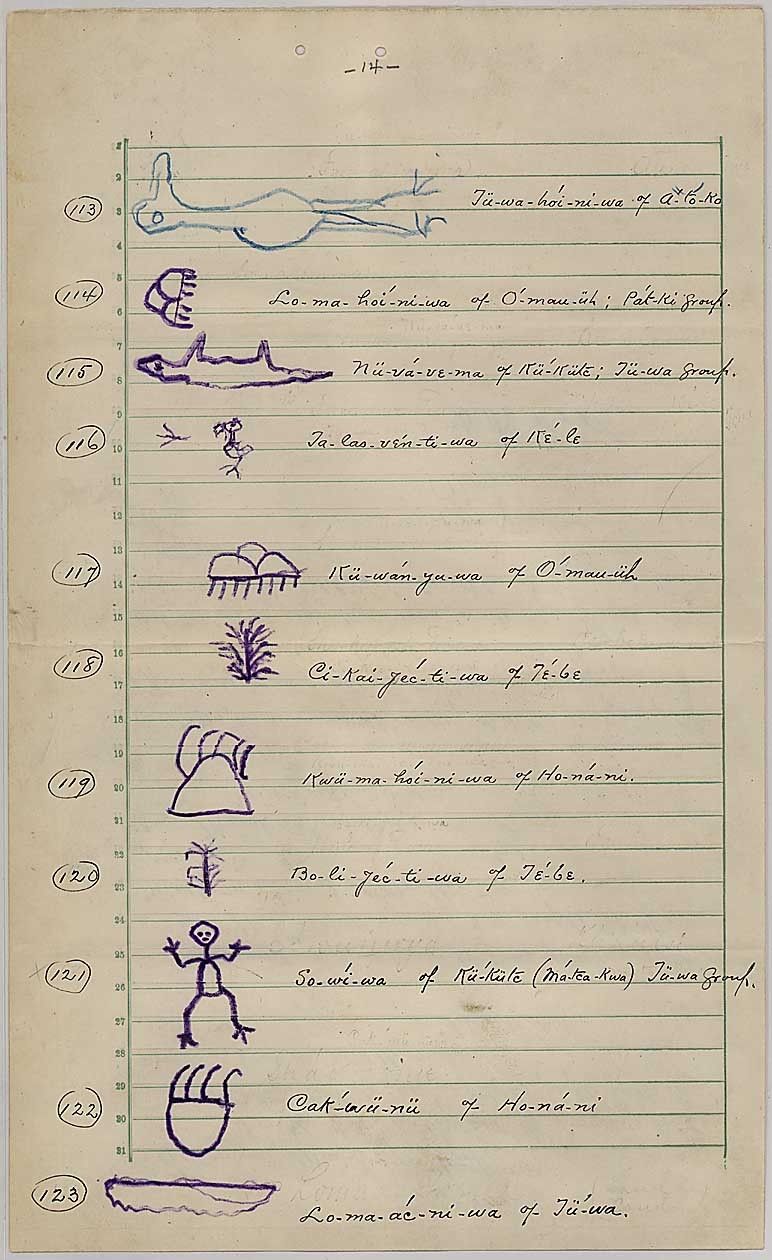
A Hopi (Moqui) Petition Signed by All the Chiefs and Headmen of the Tribe Asking the Federal Government to Give Them Title to Their Lands Instead of Individually Allotting Each Tribal Member.
Page 16
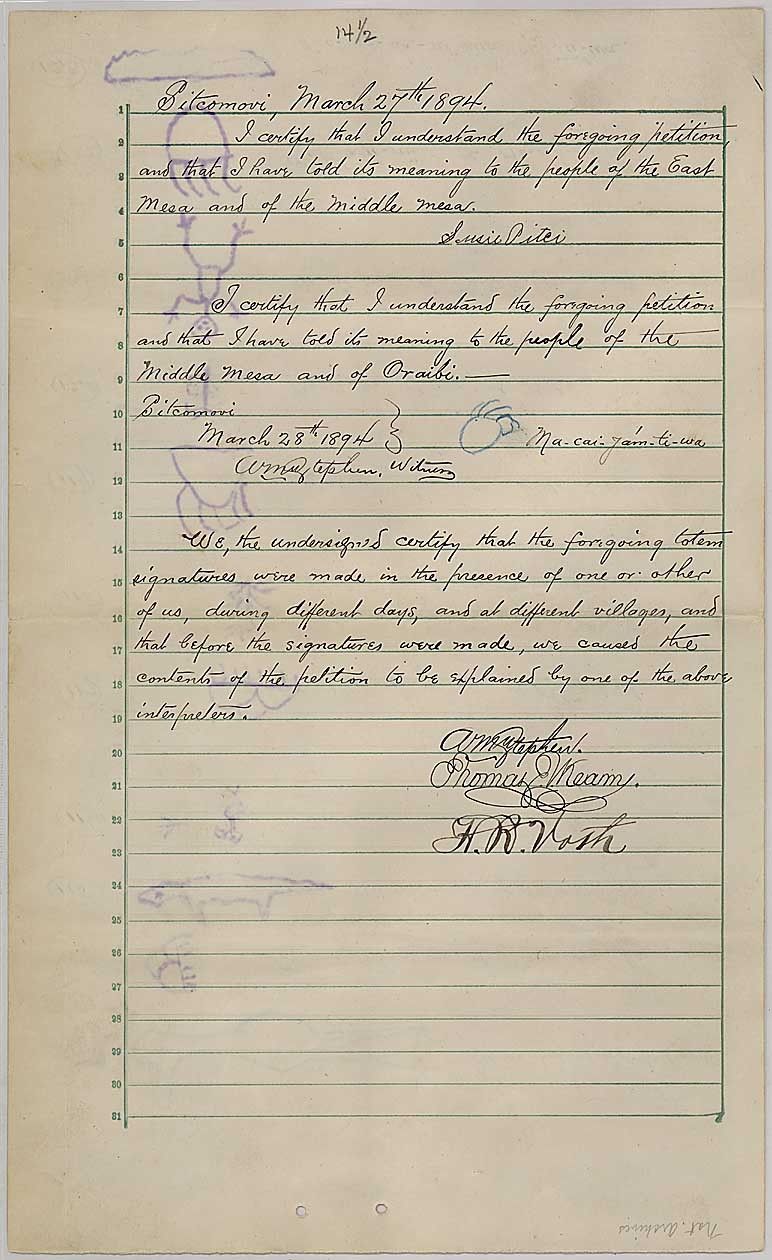
A Hopi (Moqui) Petition Signed by All the Chiefs and Headmen of the Tribe Asking the Federal Government to Give Them Title to Their Lands Instead of Individually Allotting Each Tribal Member.
Page 17
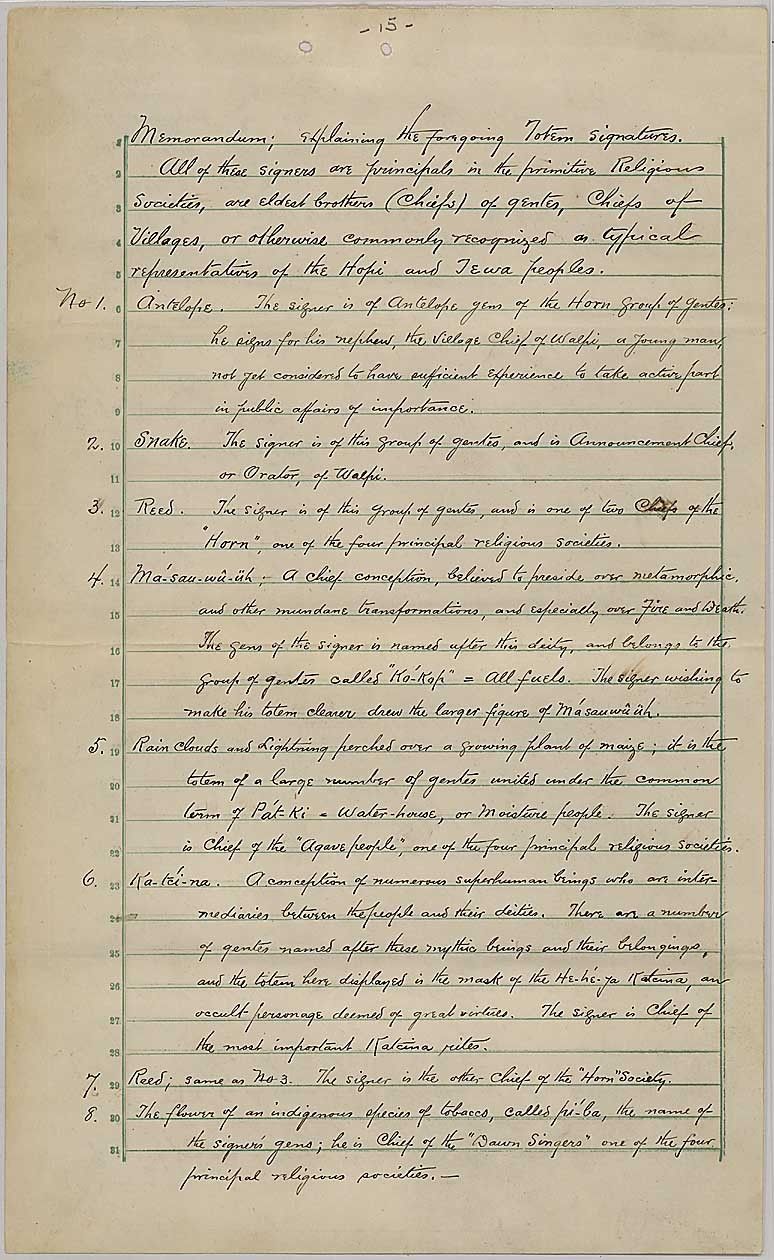
A Hopi (Moqui) Petition Signed by All the Chiefs and Headmen of the Tribe Asking the Federal Government to Give Them Title to Their Lands Instead of Individually Allotting Each Tribal Member.
Page 18
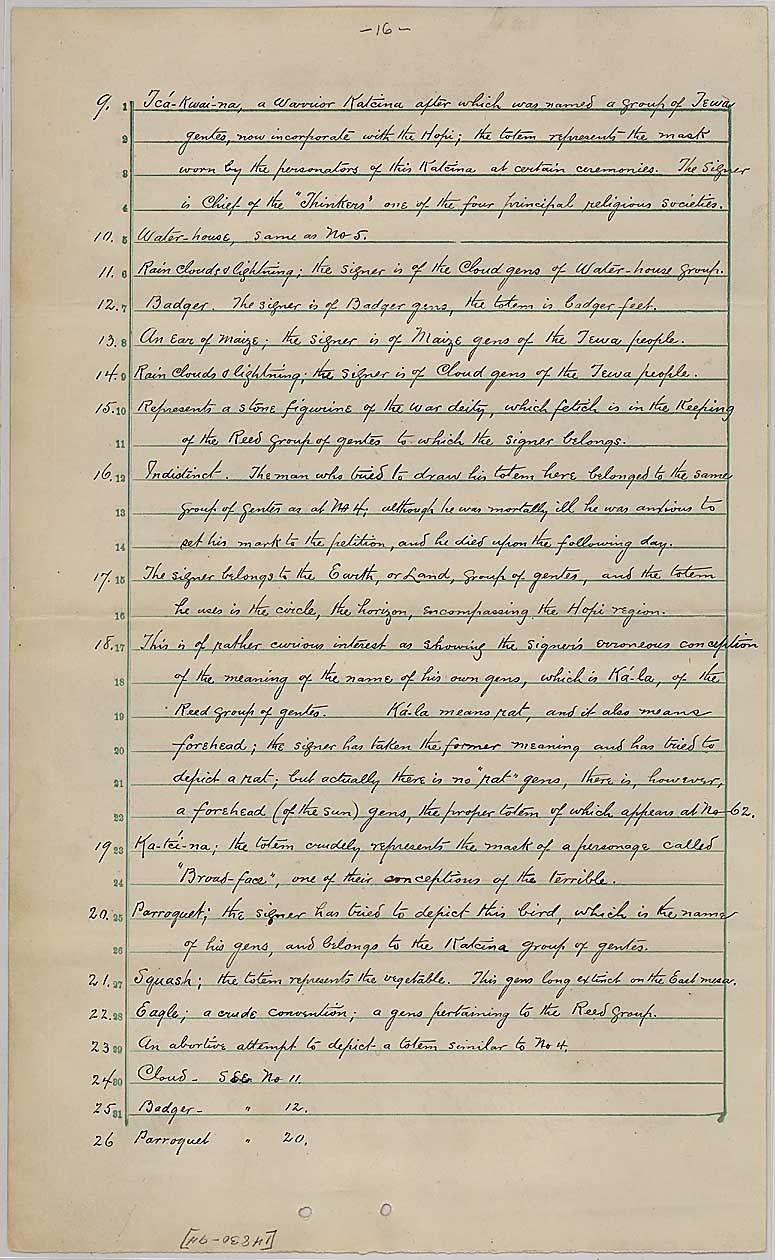
A Hopi (Moqui) Petition Signed by All the Chiefs and Headmen of the Tribe Asking the Federal Government to Give Them Title to Their Lands Instead of Individually Allotting Each Tribal Member.
Page 19
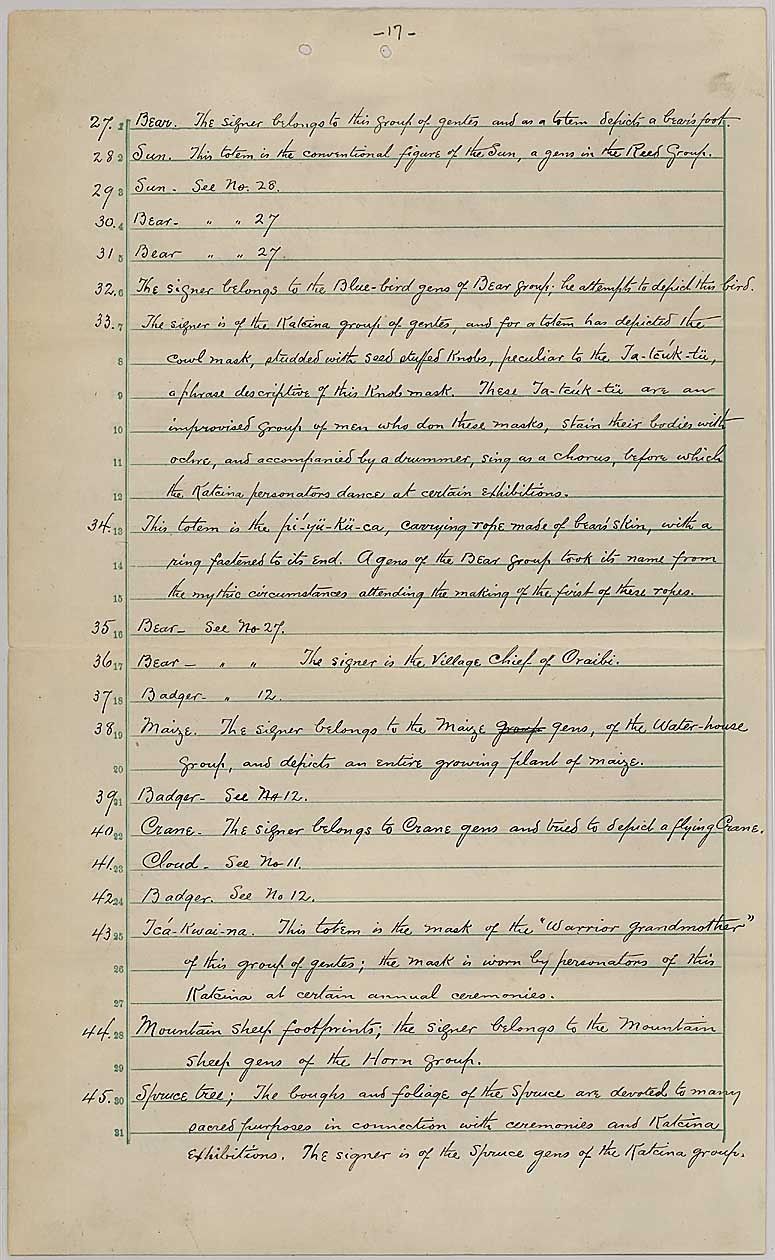
A Hopi (Moqui) Petition Signed by All the Chiefs and Headmen of the Tribe Asking the Federal Government to Give Them Title to Their Lands Instead of Individually Allotting Each Tribal Member.
Page 20

A Hopi (Moqui) Petition Signed by All the Chiefs and Headmen of the Tribe Asking the Federal Government to Give Them Title to Their Lands Instead of Individually Allotting Each Tribal Member.
Page 21
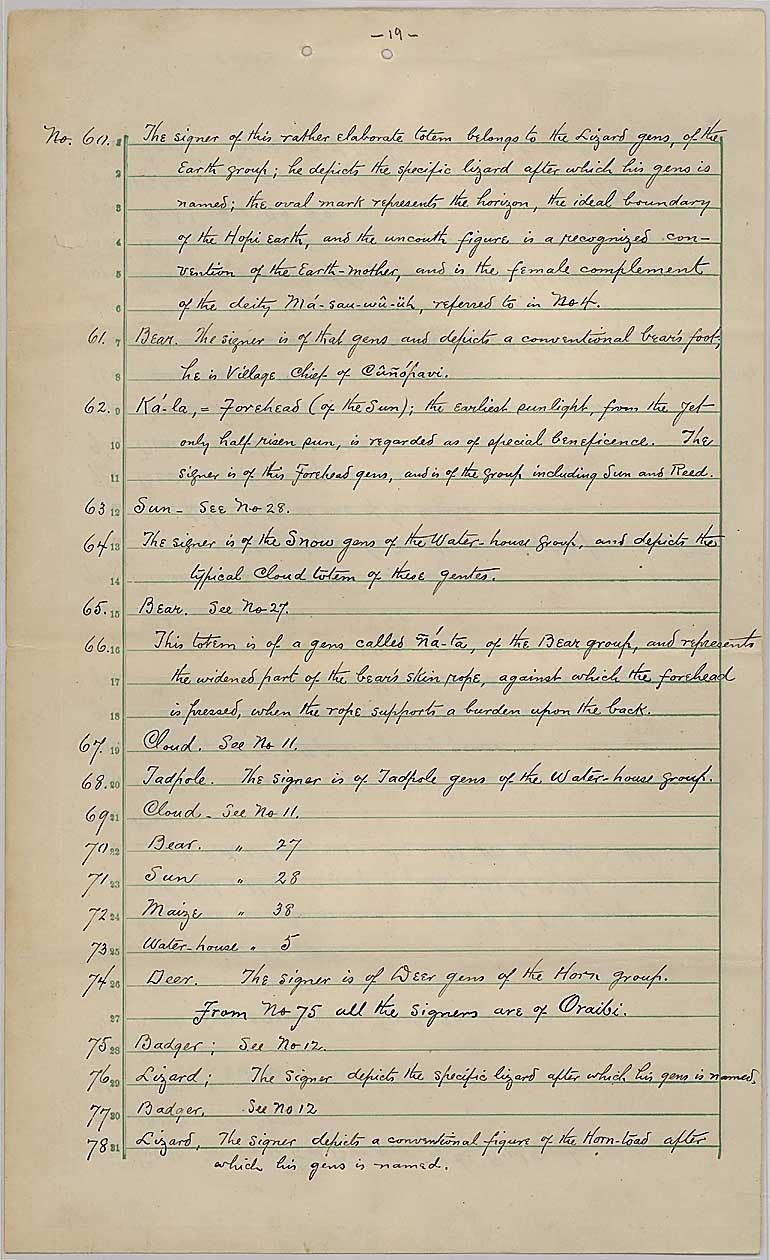
A Hopi (Moqui) Petition Signed by All the Chiefs and Headmen of the Tribe Asking the Federal Government to Give Them Title to Their Lands Instead of Individually Allotting Each Tribal Member.
Page 22

A Hopi (Moqui) Petition Signed by All the Chiefs and Headmen of the Tribe Asking the Federal Government to Give Them Title to Their Lands Instead of Individually Allotting Each Tribal Member.
Page 23

A Hopi (Moqui) Petition Signed by All the Chiefs and Headmen of the Tribe Asking the Federal Government to Give Them Title to Their Lands Instead of Individually Allotting Each Tribal Member.
Page 24

A Hopi (Moqui) Petition Signed by All the Chiefs and Headmen of the Tribe Asking the Federal Government to Give Them Title to Their Lands Instead of Individually Allotting Each Tribal Member.
Page 25

A Hopi (Moqui) Petition Signed by All the Chiefs and Headmen of the Tribe Asking the Federal Government to Give Them Title to Their Lands Instead of Individually Allotting Each Tribal Member.
Page 26

A Hopi (Moqui) Petition Signed by All the Chiefs and Headmen of the Tribe Asking the Federal Government to Give Them Title to Their Lands Instead of Individually Allotting Each Tribal Member.
Page 27
